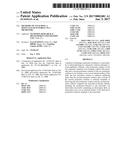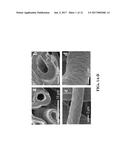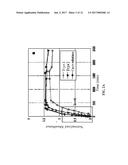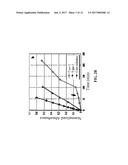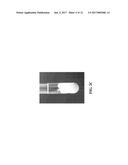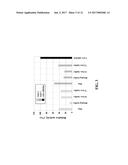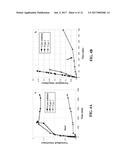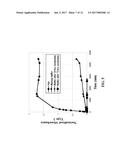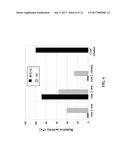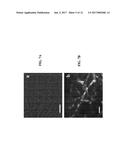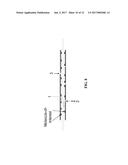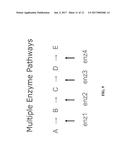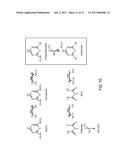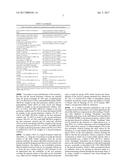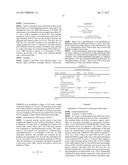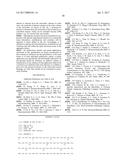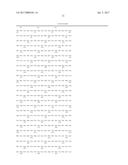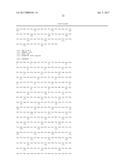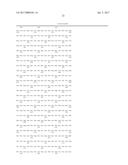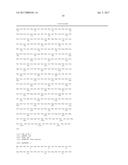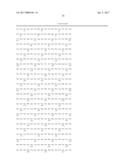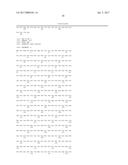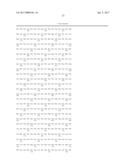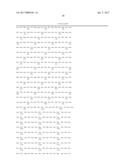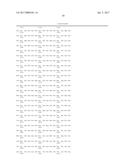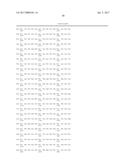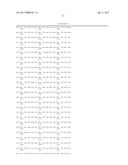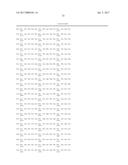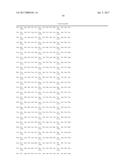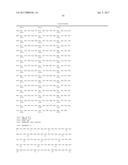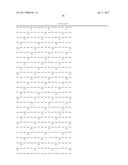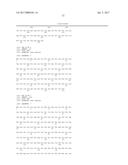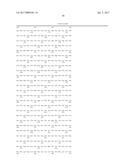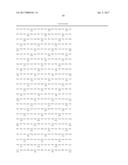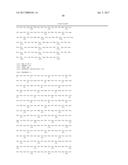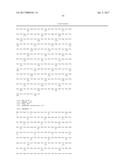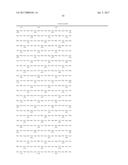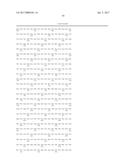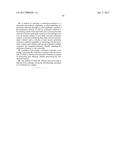Patent application title: METHODS OF ATTACHING A MOLECULE-OF-INTEREST TO A MICROTUBE
Inventors:
IPC8 Class: AD01D500FI
USPC Class:
1 1
Class name:
Publication date: 2017-01-05
Patent application number: 20170002481
Abstract:
A method of attaching a molecule-of-interest to a microtube, by
co-electrospinning two polymeric solutions through co-axial capillaries,
wherein a first polymeric solution of the two polymeric solutions is for
forming a shell of the microtube and a second polymeric solution of the
two polymeric solutions is for forming a coat over an internal surface of
the shell, the first polymeric solution is selected solidifying faster
than the second polymeric solution and a solvent of the second polymeric
solution is selected incapable of dissolving the first polymeric solution
and the second polymeric solution comprises the molecule-of-interest,
thereby attaching the molecule-of-interest to the microtube. An
electrospun microtube comprising an electrospun shell, an electrospun
coat over an internal surface of the shell and a molecule-of-interest
attached to the microtube.Claims:
1. A microtube comprising: an electrospun shell, an electrospun coat
polymer over an internal surface of said shell and a molecule-of-interest
attached to the microtube, wherein said electrospun shell is formed of a
first polymeric solution comprising a first solvent and said electrospun
coat is formed of a second polymeric solution comprising a second
solvent, wherein said second solvent of said second polymeric solution is
incapable of dissolving a polymer of said first polymeric solution,
wherein said first polymeric solution solidifies faster than said second
polymeric solution, wherein said second polymeric solution is capable of
wetting said internal surface of said shell during or following
solidification of said first polymeric solution, wherein said
molecule-of-interest is selected from the group consisting of: a
polypeptide, a polynucleotide, a carbohydrate, a polysaccharide, a lipid,
a drug molecule, and a small molecule, and wherein said small molecule is
selected from the group consisting of a nucleotide base, an amino acid, a
nucleotide, an antibiotic, and a vitamin.
2. The microtube of claim 1, wherein said polymer of said first polymeric solution and a polymer of said second polymeric solution are different.
3. The microtube of claim 1, wherein said electrospun shell comprises pores.
4. The microtube of claim 1, wherein said electrospun shell comprises a polymer selected from the group consisting of poly (e-caprolactone) (PCL), polyamide, poly(siloxane), poly(silicone), poly(ethylene), poly(vinyl pyrrolidone), poly(2-hydroxy ethylmethacrylate), poly(N-vinyl pyrrolidone), poly(methyl methacrylate), poly(vinyl alcohol), poly(acrylic acid), poly(vinyl acetate), polyacrylamide, poly(ethylene-co-vinyl acetate), poly(ethylene glycol), poly(methacrylic acid), polylactide, polyglycolide, poly(lactide-coglycolide), polyanhydride, polyorthoester, poly(carbonate), poly(acrylo nitrile), poly(ethylene oxide), polyaniline, polyvinyl carbazole, polystyrene, poly(vinyl phenol), polyhydroxy acid, poly(caprolactone), polyanhydride, polyhydroxyalkanoate, polyurethane, collagen, albumin, alginate, chitosan, starch, and hyaluronic acid.
5. The microtube of claim 1, wherein said electrospun coat comprises a polymer selected from the group consisting of poly(acrylic acid), poly(vinyl acetate), polyacrylamide, poly(ethylene-co-vinyl acetate), poly(ethylene glycol), poly(methacrylic acid), polylactide polyglycolide, poly(lactide-coglycolide), polyanhydride, polyorthoester, poly(carbonate), poly(ethylene oxide), polyaniline, polyvinyl carbazole, polystyrene, poly(vinyl phenol), polyhydroxy acid, alginate, starch, hyaluronic acid.
6. The microtube of claim 1, wherein at least one of electrospun shell and electrospun coat comprises a polymer selected from the group consisting of: collagen, albumin, alginate, chitosan, starch, and hyaluronic acid. elastin, tropoelastin, thrombin, fibronectin, poly(amino acids), poly(propylene fumarate), gelatin, pectin, fibrin, cellulose, oxidized cellulose, chitin, polyethylene, polyethylene terephthalate, poly(tetrafluoroethylene), polycarbonate, and polypropylene, or derivatives thereof.
7. The microtube of claim 1, wherein said first solvent of said first polymeric solution evaporates faster than said second solvent of said second polymeric solution, and wherein said second solvent of said second polymeric solution is capable of evaporating through said internal surface of said shell.
8. The microtube of claim 1, wherein a thickness of said shell is from about 100 nm to about 20 micrometer.
9. The microtube of claim 1, wherein an internal diameter of the microtube is from about 50 nm to about 20 micrometer.
10. The microtube of claim 1, wherein said microtube is filled with a liquid.
11. The microtube of claim 1, wherein said molecule-of-interest is attached to said coat over said internal surface of said shell.
12. The microtube of claim 1, wherein said molecule-of-interest is attached to said shell of the microtube.
13. The microtube of claim 1, wherein said first polymeric solution further comprises polyethylene glycol (PEG).
14. The microtube of claim 1, wherein said shell prevents diffusion of the molecule-of-interest therethrough.
15. A microfluidic device comprising a plurality of the microtubes of claim 1.
16. The microtube of claim 1, wherein at least one of said first polymeric solution and second polymeric solution comprises a co-polymer.
17. The microtube of claim 1, wherein at least one of said first polymeric solution and second polymeric solution comprises a blend of polymers.
18. A method of attaching a molecule-of-interest to a microtube, the method comprising: co-electrospinning two polymeric solutions through co-axial capillaries, wherein a first polymeric solution of said two polymeric solutions is for forming a shell of the microtube and a second polymeric solution of said two polymeric solutions is for forming a coat over an internal surface of said shell, said first polymeric solution is selected solidifying faster than said second polymeric solution and a solvent of said second polymeric solution is selected incapable of dissolving said first polymeric solution and wherein said second polymeric solution comprises the molecule-of-interest, thereby attaching the molecule-of-interest to the microtube.
19. A method of processing a substrate-of-interest, comprising contacting the substrate-of-interest with the microtube of claim 1, wherein said molecule-of-interest is capable of processing said substrate, thereby processing the substrate-of-interest.
20. The method of claim 19, wherein said processing is selected from isolating a molecule and detecting a presence of a molecule in a sample.
Description:
RELATED APPLICATIONS
[0001] This application claims priority from U.S. Provisional Application Nos. 61/064,210, 61/064,206 and 61/064,204 filed on Feb. 21, 2008.
[0002] The teachings of PCT/IB2007/054001 are incorporated herein by reference.
[0003] The contents of all of the above documents are incorporated by reference as if fully set forth herein.
FIELD AND BACKGROUND OF THE INVENTION
[0004] The invention, in some embodiments thereof, relates to a method of attaching a molecule-of-interest to a microtube and, more particularly, but not exclusively, to electrospun microtubes including the molecule-of-interest attached thereto.
[0005] In nature there is an enormous variety of enzymes that catalyze reactions, some of which have industrial use. These include oxidoreductases, transferases, hydrolases, lyases, isomerases, and ligases. Immobilization of enzymes on solid substrates sometimes offers advantages over the use of a free enzyme. For example, immobilization can stabilize enzymes, enable better control of enzymatic reactions, allow the reuse of the enzyme and prevent enzyme loss with time. The material bearing the immobilized enzyme has a significant role in evoking these advantages both from architectural and chemical points of view.
[0006] Nanofibers and polymeric nanofibers in particular can be produced by an electrospinning process (Reneker D H., et al., 2006; Ramakrishna S., et al., 2005; Li D., et al., 2004; PCT WO 2006/106506 to the present inventors). Electrospun polymeric nanofibers have been widely used in biological applications such as scaffolds, carriers for biologically active molecules like proteins and enzymes (Xie J., et al., 2003; Zhang Y Z., et al., 2006; Jiang H., et al., 2006; and Patel A C., et al., 2006) and encapsulation of viruses and bacteria (Salalha W., et al., 2006).
[0007] Several approaches can be used to entrap or attach enzymes to electrospun fibers. One approach is to immobilize the enzyme on the outer surface of the nanofibers by either covalently attaching the desired enzyme to the functional groups of the polymer surface (Ye P., et al., 2006; Jia H., et al., 2002; Kim T G., et al., 2006) or physically absorbing the enzyme to the surface (Huang X J., et al., 2006). The second approach, which results in encapsulation of enzymes, is based on mixing the enzyme with the polymer solution prior to the electrospinning process (Xie J. and Hsieh Y-L, 2003). However, encapsulation is often associated with leaching of the enzymes, e.g., via fiber dissolution and burst releases (Zhang Y Z., et al., 2006), especially, when the host polymer is a water soluble polymer such as poly(vinyl alcohol) (PVA) or dextran. To prevent immediate dissolution of the fibers in a physiological environment (e.g., blood) and the subsequent enzyme leaching, the electrospun fibers can be crosslinked by chemical or physical agents such as glutaraldehyde or UV irradiation. Alternatively, Zeng J, et al. (2005) suggested that PVA fibers can be coated with water insoluble polymers using a chemical vapor deposition (CVD). However, the organic solvents of the water insoluble polymers are harmful to biological material and can lead to loss of enzymatic activity. To overcome this problem, Herricks et al. (2005) suggested to use surfactant-stabilized enzymes in an organic solution of polystyrene (PS) as a spinning solution. In this way the electrospun nanofibers are insoluble in water and the enzymatic activity is retained due to surfactant stabilization (Herricks T E., et al., 2005).
[0008] Sun and co-workers (Sun Z, et al., 2003) describe the production of core-shell nanofibers (i.e., filled fibers) by co-electrospinning of two polymeric solutions using a two co-axial capillaries spinneret. US patent application No. 20060119015 to Wehrspohn R., et al. describes the production of hollow fibers by introducing a liquid containing a polymer to a porous template material, and removal of the template following polymer solidification. PCT/IB2007/054001 to the present inventors (which is fully incorporated herein by reference) discloses methods of producing electrospun microtubes (i.e., hollow fibers) which can be further filled with liquids and be used as microfluidics.
SUMMARY OF THE INVENTION
[0009] According to an aspect of some embodiments of the present invention there is provided a method of attaching a molecule-of-interest to a microtube, the method comprising: co-electrospinning two polymeric solutions through co-axial capillaries, wherein a first polymeric solution of the two polymeric solutions is for forming a shell of the microtube and a second polymeric solution of the two polymeric solutions is for forming a coat over an internal surface of the shell, the first polymeric solution is selected solidifying faster than the second polymeric solution and a solvent of the second polymeric solution is selected incapable of dissolving the first polymeric solution and wherein the second polymeric solution comprises the molecule-of-interest, thereby attaching the molecule-of-interest to the microtube.
[0010] According to an aspect of some embodiments of the present invention there is provided a microtube comprising an electrospun shell, an electrospun coat over an internal surface of the shell and a molecule-of-interest attached to the microtube.
[0011] According to an aspect of some embodiments of the present invention there is provided a method of processing a substrate-of-interest, comprising contacting the substrate-of-interest with the microtube of the invention, wherein the molecule-of-interest is capable of processing the substrate, thereby processing the substrate-of-interest.
[0012] According to an aspect of some embodiments of the present invention there is provided a method of depleting a molecule from a solution, comprising contacting the solution with the microtube of the invention, wherein the member of the affinity pair is selected capable of binding the molecule, thereby depleting the molecule from the solution.
[0013] According to an aspect of some embodiments of the present invention there is provided a method of isolating a molecule from a solution, comprising: (a) contacting the solution with the microtube of the invention under conditions which allow binding of the molecule to the microtube via the member of the affinity pair which is selected capable of binding the molecule, and; (b) eluting the molecule from the microtube; thereby isolating the molecule from the solution.
[0014] According to an aspect of some embodiments of the present invention there is provided a method of detecting a presence of a molecule in a sample, comprising: (a) contacting the sample with the microtube of the invention, wherein the member of the affinity pair is selected capable of binding the molecule, and; (b) detecting binding of the molecule by the member of the affinity pair; thereby detecting the presence of a molecule in the sample.
[0015] According to an aspect of some embodiments of the present invention there is provided a method of releasing a molecule-of-interest to cells of a subject in need thereof, comprising implanting in the subject the microtube of the invention, to thereby release the molecule-of-interest to cells of the subject.
[0016] According to some embodiments of the invention, the electrospun shell is formed of a first polymeric solution and the electrospun coat is formed of a second polymeric solution.
[0017] According to some embodiments of the invention, the first polymeric solution solidifies faster than the second polymeric solution.
[0018] According to some embodiments of the invention, a solvent of the second polymeric solution is incapable of dissolving the first polymeric solution.
[0019] According to some embodiments of the invention, the electrospun shell comprises a polymer selected from the group consisting of poly (e-caprolactone) (PCL), polyamide, poly(siloxane), poly(silicone), poly(ethylene), poly(vinyl pyrrolidone), poly(2-hydroxy ethylmethacrylate), poly(N-vinyl pyrrolidone), poly(methyl methacrylate), poly(vinyl alcohol), poly(acrylic acid), poly(vinyl acetate), polyacrylamide, poly(ethylene-co-vinyl acetate), poly(ethylene glycol), poly(methacrylic acid), polylactide, polyglycolide, poly(lactide-coglycolide), polyanhydride, polyorthoester, poly(carbonate), poly(acrylo nitrile), poly(ethylene oxide), polyaniline, polyvinyl carbazole, polystyrene, poly(vinyl phenol), polyhydroxy acid, poly(caprolactone), polyanhydride, polyhydroxyalkanoate, polyurethane, collagen, albumin, alginate, chitosan, starch, hyaluronic acid, and whereas the electrospun coat comprises a polymer selected from the group consisting of poly(acrylic acid), poly(vinyl acetate), polyacrylamide, poly(ethylene-co-vinyl acetate), poly(ethylene glycol), poly(methacrylic acid), polylactide polyglycolide, poly(lactide-coglycolide), polyanhydride, polyorthoester, poly(carbonate), poly(ethylene oxide), polyaniline, polyvinyl carbazole, polystyrene, poly(vinyl phenol), polyhydroxy acid, alginate, starch, hyaluronic acid.
[0020] According to some embodiments of the invention, a solvent of the first polymeric solution evaporates faster than a solvent of the second polymeric solution.
[0021] According to some embodiments of the invention, the electrospinning is effected using a rotating collector.
[0022] According to some embodiments of the invention, a solvent of the second polymeric solution is capable of evaporating through the internal surface of the shell.
[0023] According to some embodiments of the invention, the second polymeric solution is capable of wetting the internal surface of the shell.
[0024] According to some embodiments of the invention, a thickness of the shell is from about 100 nm to about 20 micrometer.
[0025] According to some embodiments of the invention, an internal diameter of the microtube is from about 50 nm to about 20 micrometer.
[0026] According to some embodiments of the invention, the first and the second polymeric solutions are selected from the group consisting of: 10% poly (e-caprolactone) (PCL) in chloroform (CHCl.sub.3) and dimethylforamide (DMF) (80:20 by weight) as the first polymeric solution and 4% poly(ethylene oxide) (PEO) in water (H.sub.2O) and ethanol (60:40 by weight) as the second polymeric solution, 10% PCL in CHCl.sub.3 and DMF (80:20 by weight) as the first polymeric solution and 6% PEO in H.sub.2O and ethanol (60:40 by weight) as the second polymeric solution, 9% PCL in CHCl.sub.3 and DMF (90:10 by weight) as the first polymeric solution and 7% PEO in H.sub.2O as the second polymeric solution, 10% PCL in CHCl.sub.3 and DMF (80:20 by weight) as the first polymeric solution and 9% poly(vinyl alcohol) (PVA) in water and ethanol (50:50 by weight) as the second polymeric solution, and 10% PCL in CHCl.sub.3 and DMF (90:10 by weight) as the first polymeric solution and 4% (w/w) PEO in ethanol:H.sub.2O (26:74 by weight) as a second polymeric solution.
[0027] According to some embodiments of the invention, the microtube is filled with a liquid.
[0028] According to some embodiments of the invention, the first and the second polymeric solutions are biocompatible.
[0029] According to some embodiments of the invention, the molecule-of-interest is attached to the coat over the internal surface of the shell.
[0030] According to some embodiments of the invention, the molecule-of-interest is attached to the shell of the microtube.
[0031] According to some embodiments of the invention, the molecule-of-interest comprises a polypeptide, a polynucleotide, a carbohydrate, a small molecule, or any combination thereof.
[0032] According to some embodiments of the invention, the molecule-of-interest comprises a member of an affinity pair.
[0033] According to some embodiments of the invention, the polypeptide is an enzyme.
[0034] According to some embodiments of the invention, the enzyme is alkaline phosphatase (SEQ ID NO: 1 or 8) or beta-galactosidase (SEQ ID NO:2 or 9).
[0035] According to some embodiments of the invention, the first polymeric solution comprises polyethylene glycol (PEG).
[0036] According to some embodiments of the invention, the shell comprises pores.
[0037] According to some embodiments of the invention, the shell prevents diffusion of the molecule-of-interest therethrough.
[0038] According to some embodiments of the invention, the substrate-of-interest comprises incorporating the substrate-of-interest in a synthesis reaction catalyzed by the molecule-of-interest.
[0039] According to some embodiments of the invention, the substrate-of-interest comprises incorporating the substrate-of-interest in a catabolism reaction catalyzed by the molecule-of-interest.
[0040] According to some embodiments of the invention, the method further comprising collecting the solution following the contacting.
[0041] According to some embodiments of the invention, the solution comprises blood.
[0042] According to some embodiments of the invention, the affinity pair is selected from the group consisting of an enzyme and a substrate, a hormone and a receptor, an antibody and an antigen, a polypeptide and a polynucleotide, a polynucleotide and a cognate polynucleotide, a polypeptide and a metal ion, a polypeptide and a carbohydrate.
[0043] According to some embodiments of the invention, a therapeutically effective amount of the molecule-of-interest is capable of treating a pathology in the subject.
[0044] According to some embodiments of the invention, the molecule-of-interest comprises a polypeptide, and whereas a therapeutically effective amount of the polypeptide is capable of treating a pathology in the subject.
[0045] According to some embodiments of the invention, the pathology is selected from the group consisting of a metabolic disorder, an endocrine disease, an autoimmune disease, and cancer.
[0046] According to some embodiments of the invention, the polypeptide is selected from the group consisting of insulin (SEQ ID NO:6), phenylalanine hydroxylase (PAH) (SEQ ID NO:3), dystrophin (SEQ ID NO:4), beta-glucosidase (GBA) (SEQ ID NO:5), and ceruloplasmin ferroxidase (CP) (SEQ ID NO:7).
[0047] Unless otherwise defined, all technical and/or scientific terms used herein have the same meaning as commonly understood by one of ordinary skill in the art to which the invention pertains. Although methods and materials similar or equivalent to those described herein can be used in the practice or testing of embodiments of the invention, exemplary methods and/or materials are described below. In case of conflict, the patent specification, including definitions, will control. In addition, the materials, methods, and examples are illustrative only and are not intended to be necessarily limiting.
BRIEF DESCRIPTION OF THE DRAWINGS
[0048] Some embodiments of the invention are herein described, by way of example only, with reference to the accompanying drawings. With specific reference now to the drawings in detail, it is stressed that the particulars shown are by way of example and for purposes of illustrative discussion of embodiments of the invention. In this regard, the description taken with the drawings makes apparent to those skilled in the art how embodiments of the invention may be practiced.
[0049] In the drawings:
[0050] FIGS. 1A-D are images depicting high resolution scanning electron microscope (HRSEM) micrographs of (a) Type 1 fibers with alkaline phosphatase (AP); (b) Type 2 fibers with AP; (c) Type 1 fibers with beta-galactosidase (.beta.-GAL); and (d) Type 2 fibers with .beta.-GAL;
[0051] FIGS. 2A-C are graphs (FIGS. 2a-b) and a picture (FIG. 2C) depicting the progress of the AP reactions with time for enzymes attached to (e.g., encapsulated within) the electrospun fibers and the free enzyme in the solution forming the coat over the internal surface of the shell (also referred to herein as a core solution) prior to the electrospinning. FIG. 2A--the progress of the alkaline phosphatase reaction over 2500 minutes; FIG. 2B--inset, the progress of the reaction through over the first 300 minutes; Note that the enzymatic reaction of the enzyme encapsulated within type 2 electrospun microtubes is faster than that of enzyme encapsulated within type 1 electrospun microtubes. FIG. 2C--a photograph of a piece of mat (Type 1) immersed in the assay solution. The presence of the yellow reaction product, p-nitrophenol, is apparent; the reaction substrate was para-nitrophenyl phosphate;
[0052] FIG. 3 is a histogram depicting the relative activity of AP enzyme for different types of fibers (type 1 and type 2) and in dwelling buffers. Mat=the electrospun fibers (microtubes) with the attached (encapsulated) enzymes; rinsing buffer=the buffer used to only rinse the fibers, without any additional incubation time; 24 hrs. buffer=the buffer following incubation of the fibers therein for 24 hours; 72 hrs. buffer=the buffer following incubation of the fibers therein for 72 hours; core solution=the enzyme in the core solution prior to the electrospinning process.
[0053] FIGS. 4A-B are graphs depicting the progress of the .beta.-GAL reactions with time for the two types of electrospun fibers and the free enzyme in the core solution. The substrate was ortho-nitrophenyl galactoside. FIG. 4A--the progress of the .beta.-GAL reactions over 5000 minutes as measured by the amount of ortho-nitrophenol generated; FIG. 4B--inset of the graph of FIG. 4a, the progress of the .beta.-GAL reactions over the first 50 minutes;
[0054] FIG. 5 is a graph depicting the .beta.-GAL reaction versus time for the mat and buffers for Type 2 fibers;
[0055] FIG. 6 is a histogram depicting the relative activity of the .beta.-GAL and AP for different types of fibers;
[0056] FIGS. 7A-B are fluorescence microscope micrographs depicting Type 1 fibers with AP (FIG. 7A) and .beta.-GAL (FIG. 7B). Size bars: 100 .mu.m (FIG. 7A) and 50 .mu.m (FIG. 7B).
[0057] FIG. 8 is a schematic illustration depicting the desorption process of the molecule-of-interest from the microtube of the invention. The molecule-of-interest (e.g., a protein, an enzyme) is attached to the coat over the internal surface of the shell. Following contacting the microtube with a solution, the solution enters the microtube via the pores (an exemplary pore is marked by arrow No. 3) by a capillary rise (see arrow No. 1) and gradually wets and fills the microtube inner volume. The desorption of the molecule-of-interest from the internal surface of the microtube shell (which depends mainly on the rate of the release of the molecule-of-interest from the polymer) is shown by arrow No. 2.
[0058] FIG. 9 depicts a multi-step enzymatic reaction performed using encapsulated molecules-of-interest (enzymes 1-4). Enzyme 1 (enz1) catalyzes the conversion of compound A to B; Enzyme 2 (enz2) catalyzes the conversion of compound B to C; Enzyme 3 (enz3) catalyzes the conversion of compound C to D; Enzyme 4 (enz4) catalyzes the conversion of compound D to E.
[0059] FIG. 10 is a schematic presentation depicting Atrazine degradation by the isolated Pseudomonas ADP enzymes: AtzA (atrazine chlorohydrolase, e.g., GenBank Accession No. NP_862474), AtzB (hydroxyatrazine hydrolase, e.g., GenBank Accession No. NP_862481), AtzC (N-isopropylammelide isopropylamino hydrolase, e.g., GenBank Accession No. NP_862508), AtzD (cyanuric acid amidohydrolase, e.g., GenBank Accession No NP_862537), AtzE (biuret hydrolase, e.g., GenBank Accession No. NP_862538) and AtzF (allophanate hydrolase, e.g., GenBank Accession No. AAK50333) which are attached to the microtube of the invention.
DESCRIPTION OF SPECIFIC EMBODIMENTS OF THE INVENTION
[0060] The present invention, in some embodiments thereof, relates to methods of attaching a molecule-of-interest to a microtube and, more particularly, but not exclusively, to electrospun microtubes which include a molecule-of-interest attached thereto which can be used in various therapeutic, diagnostic, purification and synthesis applications.
[0061] Before explaining at least one embodiment of the invention in detail, it is to be understood that the invention is not necessarily limited in its application to the details set forth in the following description or exemplified by the Examples. The invention is capable of other embodiments or of being practiced or carried out in various ways.
[0062] While reducing the invention to practice, the present inventors have uncovered that a molecule-of-interest can be attached to electrospun microtubes. Thus, as is shown in FIGS. 1a-b and described in Example 1 of the Examples section which follows, two types of electrospun microtubes containing active molecules-of-interest (e.g., enzymes such as alkaline phosphatase or beta-galactosidase) were formed: Type 1 microtubes which exhibit a non-porous shell, and Type 2 microtubes which exhibit a porous shell due to the presence of PEG in the polymeric solution forming the shell. The enzymatic activity contained within the microtubes was at the same order of magnitude as that of the polymeric solution prior to the electrospinning process (FIGS. 2a-b, 3, 4a-b and 6; Examples 1-3 of the Examples section which follows) indicating that surprisingly the process of production did not compromise the functionality of the delicate protein material incorporated into the tube. In addition, as is shown in FIG. 3 and described in Example 2 of the Examples section which follows, both the porous and non-porous microtubes were capable of releasing enzymes attached thereto. Moreover, during the electrospinning process, some of the alkaline phosphatase enzyme migrated to the outer surface of the microtube shell and was released therefrom into the aqueous environment (FIG. 3, Example 2), while the .beta.-GAL enzyme remained within the internal surface of the shell (FIG. 5, Example 3). In addition, as is further described in Example 3 of the Examples section which follows, the activity of the enzymes attached to the internal surface of the shell was increased in the presence of a porous shell which enabled the passage of substrates therethrough (FIGS. 4a-b). These results support the use of the microtubes of the invention as micro-reactors (e.g., bioreactors) for various synthesis, hydrolysis, isolation and purification reactions.
[0063] According to an aspect of the invention there is provided a method of attaching a molecule-of-interest to a microtube. The method is effected by co-electrospinning two polymeric solutions through co-axial capillaries, wherein a first polymeric solution of the two polymeric solutions is for forming a shell of the microtube and a second polymeric solution of the two polymeric solutions is for forming a coat over an internal surface of the shell, the first polymeric solution is selected solidifying faster than the second polymeric solution and a solvent of the second polymeric solution is selected incapable of dissolving the first polymeric solution and wherein the second polymeric solution comprises the molecule-of-interest, thereby attaching the molecule-of-interest to the microtube.
[0064] As used herein the term "microtube" refers to a hollow tube having an inner diameter of e.g., about 200 nm to about 50 .mu.m and an outer diameter of e.g., about 0.5 .mu.m to about 100 .mu.m.
[0065] According to some embodiments of the invention the thickness of the microtube shell can vary from a few nanometers to several micrometers, such as from about 100 nm to about 20 .mu.m, e.g., from about 200 nm to about 10 .mu.m, from about 100 nm to about 5 .mu.m, from about 100 nm to about 1 .mu.m, e.g., about 500 nm.
[0066] According to some embodiments of the invention the internal diameter of the microtube shell can vary from a few nanometers to several micrometers, such as from about 50 nm to about 50 .mu.m, e.g., from about 100 nm to about 20 .mu.m, from about 200 nm to about 10 .mu.m, from about 500 nm to about 5 .mu.m, from about 1 .mu.m to about 5 .mu.m, e.g., about 3 .mu.m.
[0067] According to some embodiments of the invention, the microtube may have a length which is from about 0.1 millimeter (mm) to about 20 centimeter (cm), e.g., from about 1-20 cm, e.g., from about 5-10 cm.
[0068] As used herein the term "attaching" refers to the binding of the molecule-of-interest to the polymer(s) comprised in the microtube of the invention via covalent or non-covalent binding (e.g., via an electrostatic bond, a hydrogen bond, a van-Der Waals interaction) so as to obtain an absorbed, embedded or immobilized molecule-of-interest to the microtube of the invention.
[0069] According to some embodiments of the invention, the length (L) of the microtube can be several orders of magnitude higher (e.g., 10 times, 100 times, 1000 times, 10,000 times) than the microtube's diameter (D). Accordingly, a molecule-of-interest which is attached to such a microtube is referred to as being entrapped or encapsulated within the microtube.
[0070] According to some embodiments of the invention, covalent attachment of the molecule-of-interest can be via functional groups such as SH groups, amino groups, carboxyl groups which are added to the polymer(s) forming the microtube.
[0071] As used herein the phrase "co-electrospinning" refers to a process in which at least two polymeric solutions are electrospun from co-axial capillaries (i.e., at least two capillary dispensers wherein one capillary is placed within the other capillary while sharing a co-axial orientation) forming the spinneret within an electrostatic field in a direction of a collector. The capillary can be, for example, a syringe with a metal needle or a bath provided with one or more capillary apertures from which the polymeric solution can be extruded, e.g., under the action of hydrostatic pressure, mechanical pressure, air pressure and/or high voltage.
[0072] The collector serves for collecting the electrospun element (e.g., the electrospun microtube) thereupon. Such a collector can be a rotating collector or a static (non rotating) collector. When a rotating collector is used, such a collector may have a cylindrical shape (e.g., a drum), however, the rotating collector can be also of a planar geometry (e.g., an horizontal disk). The spinneret is typically connected to a source of high voltage, such as of positive polarity, while the collector is grounded, thus forming an electrostatic field between the dispensing capillary (dispenser) and the collector. Alternatively, the spinneret can be grounded while the collector is connected to a source of high voltage, such as with negative polarity. As will be appreciated by one ordinarily skilled in the art, any of the above configurations establishes motion of a positively charged jet from the spinneret to the collector. Reverse polarity for establishing motions of a negatively charged jet from the spinneret to the collector are also contemplated.
[0073] For electrospinning, the first polymeric solution is injected into the outer capillary of the co-axial capillaries while the second polymeric solution is injected into the inner capillary of the co-axial capillaries. In order to form a microtube (i.e., a hollow structure, as mentioned above), the first polymeric solution (which is for forming the shell of the microtube) solidifies faster than the second polymeric solution (also referred herein as a core polymeric solution, and is for forming a coat over the internal surface of the shell). In addition, the formation of a microtube also requires that the solvent of the second polymeric solution be incapable of dissolving the first polymeric solution.
[0074] The solidification rates of the first and second polymeric solutions are critical for forming the microtube. For example, for a microtube of about 100 .mu.m, the solidification of the first polymer (of the first polymeric solution) can be within about 30 milliseconds (ms) while the solidification of the second polymer (of the second polymeric solution) can be within about 10-20 seconds. The solidification may be a result of polymerization rate and/or evaporation rate.
[0075] According to some embodiments of the invention; the solvent of the first polymeric solution evaporates faster than the solvent of second polymeric solution (e.g., the solvent of the first polymeric solution exhibits a higher vapor pressure than the solvent of the second polymeric solution).
[0076] According to some embodiments of the invention, the rate of evaporation of the solvent of the first polymeric solution is at least about 10 times faster than that of the solvent of the second polymeric solution. The evaporation rate of the solvent of the first polymeric solution can be at least about 100 times faster or at least about 1000 times faster than the evaporation rate of the solvent of second polymeric solution. For example, the evaporation of chloroform is significantly faster than the evaporation of an aqueous solution (water) due to the high vapor pressure at room temperature of the chloroform (195 mmHg) vs. that of the aqueous solution (23.8 mmHg).
[0077] When selecting a solvent of the second polymeric solution which is incapable of dissolving the first polymeric solution (i.e., a non-solvent of the first polymeric solution), the polymer of the first polymeric solution can solidify (e.g., through precipitation) and form a strong microtube shell which does not collapse, and is characterized by an even thickness. According to some embodiments of the invention, the first polymeric solution (e.g., the solvent of the first polymer) is substantially immiscible in the solvent of the second polymeric solution.
[0078] The solvent of the second polymeric solution may evaporate while the polymer (of the second polymeric solution) forms a thin layer on the internal surface of the shell.
[0079] According to some embodiments of the invention, the solvent of the second polymeric solution is capable of evaporating through the internal surface of the shell.
[0080] The flow rates of the first and second polymeric solutions can determine the microtube outer and inner diameter and thickness of shell. Non-limiting examples of microtubes generated by electrospinning using different flow rates are shown in Table 1 hereinbelow.
TABLE-US-00001 TABLE 1 Effect of the flow rates of the two polymeric solutions during electrospinning on microtube diameter and thickness of shell System: First polymeric R solution/ Outer d Electro- Second Flow Fiber Shell V static System polymeric rates radius thickness Voltage field No. solution (ml/hr) (.mu.m) (.mu.m) (kV) kV/cm M5 First 4 3.0-4.5 0.5 .+-. 0.1 8.5 0.43 polymeric solution Second 0.5 polymeric solution M10 First 10 2.3-4.0 1.0 .+-. 0.1 8 0.5 polymeric solution Second 0.3 polymeric solution M11 First 10 3-6 1.0 .+-. 0.1 9 0.56 polymeric solution Second 2 polymeric solution Table 1: Electrospinning was performed with the following solutions: First polymeric solution (for forming the shell) was 10% PCL in CHCl.sub.3/DMF (8:2 weight/weight); Second polymeric solution (for forming the coat) was 4% PEO in H.sub.2O/EtOH (6:4, weight/weight). PCL used was PCL 80 K; PEO used was PEO 600 K. The temperature during electrospinning was 22-26.degree. C. The relative humidity during electrospinning was 58%, 52% and 53% for systems M5, M10 and M11, respectively. The flow rates were measured in milliliter per hour (ml/hr); the outer microtube radius (R) and the shell thickness (d) were measured in microns (.mu.m). The voltage was measured in kilo volt (kV), and the electrostatic field was measured in kV per centimeter (cm). The resulting tubes were hollow (good tubes in systems M5 and M11, and mostly good in system M10).
[0081] As used herein the phrase "polymeric solution" refers to a soluble polymer, i.e., a liquid medium containing one or more polymers, co-polymers or blends of polymers dissolved in a solvent. The polymer used by the invention can be a natural, synthetic, biocompatible and/or biodegradable polymer.
[0082] The phrase "synthetic polymer" refers to polymers that are not found in nature, even if the polymers are made from naturally occurring biomaterials. Examples include, but are not limited to, aliphatic polyesters, poly(amino acids), copoly(ether-esters), polyalkylenes oxalates, polyamides, tyrosine derived polycarbonates, poly(iminocarbonates), polyorthoesters, polyoxaesters, polyamidoesters, polyoxaesters containing amine groups, poly(anhydrides), polyphosphazenes, and combinations thereof.
[0083] Suitable synthetic polymers for use by the invention can also include biosynthetic polymers based on sequences found in naturally occurring proteins such as those of collagen, elastin, thrombin, fibronectin, or derivatives thereof or, starches, poly(amino acids), poly(propylene fumarate), gelatin, alginate, pectin, fibrin, oxidized cellulose, chitin, chitosan, tropoelastin, hyaluronic acid, polyethylene, polyethylene terephthalate, poly(tetrafluoroethylene), polycarbonate, polypropylene and poly(vinyl alcohol), ribonucleic acids, deoxyribonucleic acids, polypeptides, proteins, polysaccharides, polynucleotides and combinations thereof.
[0084] The phrase "natural polymer" refers to polymers that are naturally occurring. Non-limiting examples of such polymers include, silk, collagen-based materials, chitosan, hyaluronic acid, albumin, fibrinogen, and alginate.
[0085] As used herein, the phrase "co-polymer" refers to a polymer of at least two chemically distinct monomers. Non-limiting examples of co-polymers include, polylactic acid (PLA)-polyethyleneglycol (PEG), polyethylene glycol terephthalate (PEGT)/polybutylene terephthalate (PBT), PLA-polyglycolic acid (PGA), PEG-polycaprolactone (PCL) and PCL-PLA.
[0086] As used herein, the phrase "blends of polymers" refers to the result of mixing two or more polymers together to create a new material with different physical properties.
[0087] The phrase "biocompatible polymer" refers to any polymer (synthetic or natural) which when in contact with cells, tissues or body fluid of an organism does not induce adverse effects such as immunological reactions and/or rejections, cellular death and the like. It will be appreciated that a biocompatible polymer can also be a biodegradable polymer.
[0088] According to some embodiments of the invention, the first and the second polymeric solutions are biocompatible.
[0089] Non-limiting examples of biocompatible polymers include polyesters (PE), PCL, Calcium sulfate, PLA, PGA, PEG, polyvinyl alcohol, polyvinyl pyrrolidone, Polytetrafluoroethylene (PTFE, teflon), polypropylene (PP), polyvinylchloride (PVC), Polymethylmethacrylate (PMMA), polyamides, segmented polyurethane, polycarbonate-urethane and thermoplastic polyether urethane, silicone-polyether-urethane, silicone-polycarbonate-urethane collagen, PEG-DMA, alginate, hydroxyapatite and chitosan, blends and copolymers thereof.
[0090] The phrase "biodegradable polymer" refers to a synthetic or natural polymer which can be degraded (i.e., broken down) in the physiological environment such as by proteases or other enzymes produced by living organisms such as bacteria, fungi, plants and animals. Biodegradability depends on the availability of degradation substrates (i.e., biological materials or portion thereof which are part of the polymer), the presence of biodegrading materials (e.g., microorganisms, enzymes, proteins) and the availability of oxygen (for aerobic organisms, microorganisms or portions thereof), lack of oxygen (for anaerobic organisms, microorganisms or portions thereof) and/or other nutrients. Examples of biodegradable polymers/materials include, but are not limited to, collagen (e.g., Collagen I or IV), fibrin, hyaluronic acid, polylactic acid (PLA), polyglycolic acid (PGA), polycaprolactone (PCL), polydioxanone (PDO), trimethylene carbonate (TMC), polyethyleneglycol (PEG), collagen, PEG-DMA, alginate, chitosan copolymers or mixtures thereof.
[0091] According to some embodiments, the polymeric solution can be made of one or more polymers, each can be a polymer or a co-polymer such as described hereinabove.
[0092] According to some embodiments of the invention, the polymeric solution of the invention is a mixture of at least one biocompatible polymer and a co-polymer (either biodegradable or non-biodegradable).
[0093] According to some embodiments of the invention, the first polymeric solution for forming the shell can be made of a polymer such as poly (e-caprolactone) (PCL), polyamide, poly(siloxane), poly(silicone), poly(ethylene), poly(vinyl pyrrolidone), poly(2-hydroxy ethylmethacrylate), poly(N-vinyl pyrrolidone), poly(methyl methacrylate), poly(vinyl alcohol), poly(acrylic acid), poly(vinyl acetate), polyacrylamide, poly(ethylene-co-vinyl acetate), poly(ethylene glycol), poly(methacrylic acid), polylactide, polyglycolide, poly(lactide-coglycolide), polyanhydride, polyorthoester, poly(carbonate), poly(acrylo nitrile), poly(ethylene oxide), polyaniline, polyvinyl carbazole, polystyrene, poly(vinyl phenol), polyhydroxy acid, poly(caprolactone), polyanhydride, polyhydroxyalkanoate, polyurethane, collagen, albumin, alginate, chitosan, starch, hyaluronic acid, and blends and copolymers thereof.
[0094] According to some embodiments of the invention, the second polymeric solution for forming the coat over the internal surface of the shell can be made of a polymer such as poly(acrylic acid), poly(vinyl acetate), polyacrylamide, poly(ethylene-co-vinyl acetate), poly(ethylene glycol), poly(methacrylic acid), polylactide, polyglycolide, poly(lactide-coglycolide), polyanhydride, polyorthoester, poly(carbonate), poly(ethylene oxide), polyaniline, polyvinyl carbazole, polystyrene, poly(vinyl phenol), polyhydroxy acid, alginate, starch, hyaluronic acid, and blends and copolymers thereof.
[0095] During the formation of the microtube shell (e.g., following the solidification of the first polymeric solution) the second polymeric solution flows within the internal surface of the shell.
[0096] According to some embodiments of the invention, the second polymeric solution is selected capable of wetting the internal surface of the shell.
[0097] Various polymeric solutions which are known in the art as capable of wetting other polymeric surfaces (for forming the shell) can be used. Following is a non-limiting list of pairs of polymeric solutions in which the second polymeric solution is capable of wetting the internal surface of the shell formed by the first polymeric solution.
TABLE-US-00002 TABLE 2 Pairs of polymeric solutions for producing the microtube of the invention First polymeric solution forming the Second polymeric solution capable of shell wetting the internal surface of the shell 10% poly (e-caprolactone) (PCL); in 4% poly(ethylene oxide) (PEO); in water chloroform (CHCl.sub.3) and (H.sub.2O) and ethanol (60:40 by weight) dimethylforamide (DMF) (80:20 by weight) Nylon 6,6 in formic acid 7 to 12 wt % 4% poly(ethylene oxide) (PEO); in water (H.sub.2O) and ethanol (60:40 by weight) Poly(L-lactide-co-glycolide) (PLGA 4% poly(ethylene oxide) (PEO) in water 10:90) in hexafluroisopropanol (HFIP) (H.sub.2O) and ethanol (60:40 by weight) concentrations ranging from 2 to 7 weight % solution. Poly(L-lactide-co-glycolide) (PLGA 4% poly(ethylene oxide) (PEO); in water 15:85) hexafluroisopropanol (HFIP) (H.sub.2O) and ethanol (60:40 by weight) concentrations ranging from 2 to 7 weight % solution. poly(lactide-co-glycolide) (PLGA; 4% poly(ethylene oxide) (PEO); in water 1-lactide/glycolide_50/50) (H.sub.2O) and ethanol (60:40 by weight) 1,1,1,3,3,3-hexafluoro-2-propanol (HFIP) concentrations ranging from 2 to 7 weight % solution. polyglycolide (PGA) in chloroform 3-10 9% poly(vinyl alcohol) (PVA); in water weight % solution. and ethanol (50:50 by weight) poly(L-lactide) (PLA) in chloroform 3-10 9% poly(vinyl alcohol) (PVA); in water weight % solution. and ethanol (50:50 by weight) Segmented polyurethane in DMF and 9% poly(vinyl alcohol) (PVA); in water THF (80:20 by weight) and ethanol (50:50 by weight) Polyurethane in DMF and 9% poly(vinyl alcohol) (PVA); in water tetrahydrofuran, THF (80:20 by weight) and ethanol (50:50 by weight) PLGA (poly lactic-co-glycolic acid); in 9% poly(vinyl alcohol) (PVA); in water chloroform and DMSO (dimethyl and ethanol (50:50 by weight) sulfoxide) in chloroform and DMSO (80:20 by weight). 10% PCL in CHCl.sub.3/DMF (80:20 by 6% PEO in H.sub.2O/EtOH (60:40 by weight) weight) 9% PCL in CHCl.sub.3/DMSO (90:10 by 7% PEO in H.sub.2O weight) 10% PCL in CHCl.sub.3/DMF (80:20 by 9% PVA in ethanol/water (50:50 by weight) weight) 10% PCL 80 K CHCl.sub.3:DMF (90:10 by 4% (w/w) PEO 600 K; in ethanol:H.sub.2O weight) (26:74 by weight) 10% PCL 80 K + 1% PEG 6 K 4% (w/w) PEO 600 K; in ethanol:H.sub.2O CHCl.sub.3:DMF (90:10 by weight) (26:74 by weight) Table 2. The polymers forming the solutions and the solvents are provided by weight ratios, i.e., a weight/weight (w/w) ratio.
[0098] According to some embodiments of the invention, the first and the second polymeric solutions are selected from the group consisting of: 10% poly (e-caprolactone) (PCL) in chloroform (CHCl.sub.3) and dimethylforamide (DMF) (80:20 by weight) as the first polymeric solution and 4% poly(ethylene oxide) (PEO) in water (H.sub.2O) and ethanol (60:40 by weight) as the second polymeric solution, 10% PCL in CHCl.sub.3 and DMF (80:20 by weight) as the first polymeric solution and 6% PEO in water and ethanol (60:40 by weight) as the second polymeric solution, 9% PCL in CHCl.sub.3 and DMF (90:10 by weight) as the first polymeric solution and 7% PEO in water as the second polymeric solution, 10% PCL in CHCl.sub.3 and DMF (80:20 by weight) as the first polymeric solution and 9% poly(vinyl alcohol) (PVA) in water and ethanol (50:50 by weight) as the second polymeric solution and 10% PCL in CHCl.sub.3 and DMF (90:10 by weight) as the first polymeric solution and 4% (w/w) PEO in ethanol:H.sub.2O (26:74 by weight) as a second polymeric solution.
[0099] To enable a flow of a liquid-of-interest within the microtube, i.e., along the coat polymer covering the internal surface of the shell (which originates from the second polymer solution), the surface (thin film) formed by the coat polymer should be designed such that it can be wetted by the liquid-of-interest. The ability to wet (wettability) polymer films by liquids is known in the art. For example, silicone oil or water can wet a surface made of a PEO polymer. It will be appreciated that the wettability of the coat polymer covering the internal surface of the shell can be controlled (e.g., improved) for example by attaching functional groups such as hydroxyl groups (OH) which increase the hydrophilicity of the coat by a plasma treatment [see Thurston R M, Clay J D, Schulte M D, Effect of atmospheric plasma treatment on polymer surface energy and adhesion, Journal of Plastic Film & Sheeting 23 (1): 63-78 January 2007; which is incorporated within by reference].
[0100] As is further discussed hereinabove and in the Examples section which follows, for certain applications the microtube shell may comprise pores, thus creating a "breathing" tube. Methods of forming "breathing" microtube microtubes with pores in the shell thereof) are described in PCT/IB2007/054001 to the present inventors, which is fully incorporated herein by reference. Briefly, "breathing" tubes can be formed by the inclusion of a high percent (e.g., at least 80%) of a volatile component such as tetrahydrofuran (THF), chloroform, acetone, or trifluoroethanol (TFE) in the first polymeric solution forming the shell, and/or by the inclusion of a water-soluble polymer such as polyethylene glycol (PEG) in the first polymeric solution forming the shell so that the first polymeric solution comprises a blend of polymers in which one is water-soluble and the other is water-insoluble (e.g., a blend of PEG and PCL). Alternatively, "breathing" microtubes can be formed by inducing pores in the shell after the completion of the electrospinning process, essentially as described in PCT WO 2006/106506 to the present inventors, which is fully incorporated herein by reference, such as by passing an electrical spark or a heated puncturing element through the electrospun shell, or by using a pulsed or continuous laser beam through the electrospun shell.
[0101] According to some embodiments of the invention, the first polymeric solution comprises PEG for inducing pores in the shell. For example, to generate pores greater (>) than 150 nm in diameter, the first polymeric solution may include about 4% PEG MW 35 kDa. Similarly, to generate pores smaller (<) than 150 nm in diameter, the first polymeric solution may include about 2% PEG MW 6 kDa.
[0102] The microtube shell of the invention can be designed such that it enables the passage of certain molecules (e.g., a substrate of an enzyme) while preventing the passage of other molecules (e.g., a certain enzyme), depending on the geometry (pore size) and/or the electrical charge of the molecules with respect to the geometry (length and radius), surface energy, electrical charge of the nanopore(s) of the shell, and the viscosity and surface tension of the liquid containing the molecules (e.g., the substrate of the enzyme). In addition, the porosity and pore size of the shell can control the release of the molecule-of-interest which is attached to the microtube. For example, a higher porosity and/or pore size can result in increased rate of release of the molecule-of-interest.
[0103] Alternatively, the microtube shell can be made such that it prevents diffusion or any passage of the molecule-of-interest therethrough (i.e., substantially devoid of pores, or with pores smaller than the molecule-of-interest).
[0104] As mentioned, the second polymeric solution comprises the molecule-of-interest. Such a molecule (or molecules) can be any naturally occurring or synthetic molecule such as a polypeptide, a polynucleotide, a carbohydrate or a polysaccharide, a lipid, a drug molecule, a small molecule (e.g., a nucleotide base, an amino acid, a nucleotide, an antibiotic, a vitamin or a molecule which is smaller than 0.15 kDa), or any combination thereof. The molecule-of-interest can be produced by recombinant DNA technology or by known synthesis methods such as solid phase.
[0105] According to some embodiments of the invention, the molecule-of-interest comprises a polypeptide such as an enzyme. Such polypeptides (e.g., enzymes) can be naturally occurring (e.g., mammals such as primates, rodents and Homo sapiens, plants, fungi, protozoa, bacteria and viruses) or synthetic (e.g., derived from in vitro evolution) and can be selected according to the desired application.
[0106] The following non-limiting list of enzymes can be attached to the microtube of the invention: DNA polymerase (EC 2.7.7.7), DNase (EC 3.1.11.4), RNA polymerase (EC 2.7.7.6), DNA ligase (EC 6.5.1.1), RNA ligase (EC 6.5.1.3), alcohol dehydrogenase (EC 1.1.1.1), homoserine dehydrogenase (EC 1.1.1.3), acetoin dehydrogenase (EC 1.1.1.5), glycerol dehydrogenase (EC 1.1.1.6), L-xylulose reductase (EC 1.1.1.10), L-arabinitol 2-dehydrogenase (EC 1.1.1.13), L-iditol 2-dehydrogenase (EC 1.1.1.14), mannitol-1-phosphate 5-dehydrogenase (EC 1.1.1.17), mannitol 2-dehydrogenase (EC 1.1.1.138), glucose oxidase (EC 1.1.3.4), L-sorbose oxidase (EC 1.1.3.11), lactate-malate transhydrogenase (EC 1.1.99.7), formaldehyde dehydrogenase (EC 1.2.1.1), aryl-aldehyde dehydrogenase (EC 1.2.1.29), aldehyde oxidase (EC 1.2.3.1), pyruvate synthase (EC 1.2.7.1), cortisone .alpha.-reductase (EC 1.3.1.4), lathosterol oxidase (EC 1.33.2), D-proline reductase (EC 1.4.4.1), dihydrofolate reductase (EC 1.5.1.3), methylenetetrahydrofolate reductase (NADPH) (EC 1.5.1.20), cystine reductase (NADH) (EC 1.6.1.4), cob(II)alamin reductase (EC 1.6.99.9), sulfite reductase (EC 1.8.1.2), cytochrome-c oxidase (EC 1.9.3.1), NADH peroxidase (EC 1.11.1.1), homogentistate 1,2-dioxygenase (EC 1.13.11.5), Photinus-luciferin 4-monooxygenase (1.13.12.7), anthranilate 3-monooxygenase (EC 1.14.13.35), steroid 9.alpha.-monooxygenase (EC 1.14.99.25), mercury(II) reductase (EC 1.16.1.1), nicotinamide N-methyltransferase (EC 2.1.1.1), thymidylate synthase (EC 2.1.1.45), site-specific DNA-methyltransferase (adenine-specific) (EC 2.1.1.72), tryptophan 2-C-methyltransferase (EC 2.1.1.106), glycine formininotransferase (EC 2.1.2.4), aspartate carbamoyltransferase (EC 2.1.3.2), transaldolase (EC 2.2.1.2), arylamine N-acetyltransferase (EC 2.3.1.5), arginine N-succinyltransferase (EC 2.3.1.109), phosphorylase (EC 2.4.1.1), glycosaminoglycan galactosyltransferase (EC 2.4.1.74), thymidine phosphorylase (EC 2.4.2.4), .beta.-galactoside .alpha.-2,6-sialyltransferase (EC 2.4.99.1), galactose-6-sulfurylase (EC 2.5.1.5), aspartate transaminase (2.6.1.1), hexokinase (EC 2.7.1.1), choline kinase (EC 2.7.1.32), acetate kinase (EC 2.7.2.1), creatine kinase (EC 2.7.3.2), adenylate kinase (EC 2.7.4.3), nucleotide pyrophosphokinase (EC 2.7.6.4), sulfate adenylyltransferase (ADP) (EC 2.7.7.5), aryl sulfotransferase (EC 2.8.2.1), carboxylesterase (3.1.1.1), acetyl-CoA hydrolase (EC 3.1.2.1), alkaline phosphatase (3.1.3.1), phosphodiesterase I (EC 3.1.4.1), dGTPase (EC 3.1.5.1), steryl-sulfatase (EC 3.1.6.2), exodeoxyribonuclease I (EC 3.1.11.1), ribonuclease T1 (EC 3.1.27.3), .alpha.-amylase (EC 3.2.1.1), purine nucleosidase (EC 3.2.2.1), epoxide hydrolase (EC 3.3.2.3), lysyl aminopeptidase (EC 3.4.11.15), carboxypeptidase A2 (EC 3.4.17.15), trypsin (EC 3.4.21.4), glutaminase (EC 3.5.1.2), barbiturase (EC 3.5.2.1), ATP deaminase (EC 3.5.4.18), inorganic pyrophosphatase (EC 3.6.1.1), oxaloacetase (EC 3.7.1.1), oxalate decarboxylase (EC 4.1.1.2), mandelonitrile lyase (EC 4.1.2.10), isocitrate lyase (4.1.3.1), fumarate hydratase (EC 4.2.1.2), pectate lyase (EC 4.2.2.2), histidine ammonia-lyase (EC 4.3.1.3), cyanate lyase (4.3.99.1), cysteine lyase (EC 4.4.1.10), DDT-dehydrochlorinase (EC 4.5.1.1), adenylate cyclase (EC 4.6.1.1), alanine racemase (5.1.1.1). tartrate epimerase (EC 5.1.2.5), retinal isomerase (EC 5.2.1.3), L-rhamnose isomerase (EC 5.3.1.14), prostaglandin-D synthase (EC 5.3.99.2), phosphoglucomutase (EC 5.4.2.2), lanosterol synthase (EC 5.4.99.7), DNA topoisomerase (EC 5.99.1.2), tyrosine-tRNA ligase (EC 6.1.1.1), acetate-CoA ligase (EC 6.2.1.1), acetylcholinesterase (EC 3.1.1.7), butyrylcholinesterase (EC 3.1.1.8) and glutathione synthase (EC 6.3.2.3).
[0107] According to an embodiment of the invention, the enzyme which is attached to the microtube is alkaline phosphatase (e.g., SEQ ID NO:1 or 8; EC 3.1.3.1) or beta-galactosidase (e.g., SEQ ID NO:2 or 9; EC 3.2.1.23).
[0108] The term "polynucleotide" as used herein refers to a single stranded or double stranded oligomer or polymer of ribonucleic acid (RNA) or deoxyribonucleic acid (DNA) or mimetics thereof. This term includes polynucleotides composed of naturally-occurring bases, sugars and covalent internucleoside linkages (e.g., backbone) as well as polynucleotides having non-naturally-occurring portions which function similarly to respective naturally-occurring portions.
[0109] The polynucleotide which is attached to the microtube of the invention can be generated according to any oligonucleotide synthesis method known in the art such as enzymatic synthesis, liquid phase or solid phase synthesis (using a commercially available equipment from, for example, Applied Biosystems). Equipment and reagents for executing solid-phase synthesis are commercially available from, for example, Applied Biosystems. Any other means for such synthesis may also be employed; the actual synthesis of the oligonucleotides is well within the capabilities of one skilled in the art and can be accomplished via established methodologies as detailed in, for example, "Molecular Cloning: A laboratory Manual" Sambrook et al., (1989); "Current Protocols in Molecular Biology" Volumes I-III Ausubel, R. M., ed. (1994); Ausubel et al., "Current Protocols in Molecular Biology", John Wiley and Sons, Baltimore, Md. (1989); Perbal, "A Practical Guide to Molecular Cloning", John Wiley & Sons, New York (1988) and "Oligonucleotide Synthesis" Gait, M. J., ed. (1984) utilizing solid phase chemistry, e.g. cyanoethyl phosphoramidite followed by deprotection, desalting and purification by for example, an automated trityl-on method or HPLC. Liquid phase synthesis of oligonucleotides can be performed using methods known in the art (see for example, Bonora G M, et al., 1998, Biol. Proced. Online. 1: 59-69; Padiya K J and Salunkhe M M., 2000, Bioorg. Med. Chem. 8: 337-42). It will be appreciated that for the preparation of multiple labeled polynucleotides, a large scale oligonucleotide synthesis can be utilized essentially as described elsewhere (Anderson N G. et al., Appl Biochem Biotechnol. 1995 July-September; 54(1-3):19-42; Rahmann S., Proc IEEE Comput Soc Bioinform Conf. 2002; 1:54-63).
[0110] Additionally or alternatively, the polynucleotide which is attached to the microtube of the invention can be generated by recombinant DNA techniques using any known DNA replication or transcription system (e.g., using bacterial cells, eukaryotic cells).
[0111] As mentioned, the molecule-of-interest can be a drug molecule. Such a drug can be any synthetic, chemical or biological molecule.
[0112] Non-limiting examples of biological drug molecules include antisense oligonucleotides, Ribozymes, DNAzymes, siRNA, receptor agonists, antagonists, hormones, growth factors and antibodies. Non-limiting examples of which chemical drug molecules include chemotherapy agents, Paclitaxel (Taxol.RTM.), radiation seed particles (e.g., see Hypertext Transfer Protocol://World Wide Web (dot) oncura (dot) corn), as well as natural or synthetic vitamins.
[0113] The molecule-of-interest which is attached to the microtube of the invention can be labeled. Such a label can be an intrinsic property of the molecule-of-interest (e.g., as in the case of green fluorescent protein) or can be a label which is attached to the molecule-of-interest using known methods. For example, the label can be a fluorescent labeling in which a fluorophore (i.e., an entity which can be excited by light to emit fluorescence) or a radio-isotope is conjugated via a linker or a chemical bond to the molecule-of-interest. Alternatively, the molecule-of-interest can be indirectly labeled via a covalently conjugated enzyme (e.g., horse radish peroxidase) and a covalently conjugated substrate (e.g., o-phenylenediamine) which upon interaction therebetween yield a colorimetric or fluorescent color.
[0114] The molecule-of-interest can also comprise a member of an affinity pair, which is capable of reversibly or non-reversibly binding with high affinity (e.g., less than 10.sup.-7 M, e.g., less than 10.sup.-8 M, less than 10.sup.-9, less than 10.sup.-10 M) to a specific molecule. For example, the affinity pair can be an enzyme-substrate pair, a polypeptide-polypeptide pair (e.g., a hormone and receptor, a ligand and receptor, an antibody and an antigen, two chains of a multimeric protein), a polypeptide-small molecule pair (e.g., avidin or streptavidin with biotin, enzyme-substrate), a polynucleotide and its cognate polynucleotide such as two polynucleotides forming a double strand (e.g., DNA-DNA, DNA-RNA, RNA-DNA), a polypeptide-polynucleotide pair (e.g., a complex formed of a polypeptide and a DNA or RNA e.g., aptamer), a polypeptide-metal pair (e.g., a protein chelator and a metal ion), a polypeptide and a carbohydrate (leptin-carbohydrate), and the like.
[0115] The molecule-of-interest, which is comprised within the second polymeric solution, can be attached to the coat over the internal surface of the shell. For example, as shown in FIG. 5 and described in Example 3 of the Examples section which follows, most of the n-GAL enzymatic activity was detected inside the microtube, demonstrating the attachment of the enzyme to the coat over the internal surface of the shell.
[0116] During the electrospinning process some molecules-of-interest which are comprised within the second polymeric solution may migrate to the outer surface of the shell (i.e., mixed with the first polymeric solution) depending on their charge state, size and geometry. For example, as shown in FIG. 3 and described in Example 2 of the Examples section which follows, some of the alkaline phosphatase activity was detected in the rinsing buffer of the microtube.
[0117] According to some embodiments of the invention attachment of the molecule-of-interest is performed following microtube formation. For example, the microtube can be soaked with a solution containing the molecule-of-interest. The molecule-of-interest can diffuse through the shell pores and enter the inner lumen of the microtube. In addition, the microtube can be covalently attached to the molecule-of-interest (e.g., via SH groups).
[0118] Regardless of the method of production, the present invention provides a microtube which comprises an electrospun shell, an electrospun coat over an internal surface of the shell and a molecule-of-interest attached to the microtube.
[0119] As used herein, the phrase "electrospun shell" refers to a hollow element of a tubular shape, made of one or more polymers, produced by the process of electrospinning as detailed above.
[0120] As used herein the phrase "electrospun coat" refers to a thin layer covering the internal surface of the shell of the microtube of the invention which is made of one or more polymers by the process of electrospinning as detailed above.
[0121] One of ordinary skill in the art will know how to distinguish an electrospun object from objects made by means which do not comprise electrospinning by the high orientation of the macromolecules, the skin (e.g., shell) morphology, and the typical dimensions of the microtube which are unique to electrospinning.
[0122] The microtube of the invention can be an individual (e.g., single or separated) microtube or can form part of a plurality (e.g., an aligned array) of microtubes which can be either connected to each other or separated (as single, not-connected microtubes).
[0123] For the production of a single microtube a fork like clip is attached to the edge of the rotating disk. The disk is rotated for 1-2 seconds and individual microtubes are formed between the sides of the clip. In a similar way individual electrospun fibers were collected (see E. Zussman, M. Burman, A. L. Yarin, R. Khalfin, Y. Cohen, "Tensile Deformation of Electrospun Nylon 6,6 Nanofibers," Journal of Polymer Science Part B: Polymer Physics, 44, 1482-1489, 2006, herein incorporated by reference in its entirety).
[0124] Alternatively, when using a rotating collector, a plurality of microtubes can be formed and collected on the edge of the collector as described elsewhere for electrospun fibers (A. Theron, E. Zussman, A. L. Yarin, "Electrostatic field-assisted alignment of electrospun nanofibers", Nanotechnology J., 12, 3: 384-390, 2001; herein incorporated by reference in its entirety).
[0125] The plurality of microtubes can be arranged on a single layer, or alternatively, the plurality of microtubes define a plurality of layers hence form a three dimensional structure. The microtubes can have a general random orientation, or a preferred orientation, as desired. For example, when the fibers are collected on a cylindrical collector such as a drum, the microtubes can be aligned predominantly axially or predominantly circumferentially. Different layers of the electrospun microtubes can have different orientation characteristics. For example, without limiting the scope of the present invention to any specific ordering or number of layers, the microtubes of a first layer can have a first predominant orientation, the microtubes of a second layer can have a second predominant orientation, and the microtubes of third layer can have general random orientation.
[0126] The microtube of the invention can be available as a dry fibrous mat(s) (e.g., as spun dry microtubes) or as a wetted mat(s) (e.g., following immersing or filling the microtube with a liquid).
[0127] The microtube of the invention which is attached to the molecule-of-interest may be configured as or in a microfluidics device. "Lab-on-a-chip" is described in a series of review articles [see for example, Craighead, H. Future lab-on-a-chip technologies for interrogating individual molecules. Nature 442, 387-393 (2006); deMello, A. J. Control and detection of chemical reactions in microfluidic systems. Nature 442, 394-402 (2006); El-Ali, J., Sorger, P. K. & Jensen, K. F. Cells on chips. Nature 442, 403-411 (2006); Janasek, D., Franzke, J. & Manz, A. Scaling and the design of miniaturized chemical-analysis systems. Nature 442, 374-380 (2006); Psaltis, D., Quake, S. R. & Yang, C. H. Developing optofluidic technology through the fusion of microfluidics and optics. Nature 442, 381-386 (2006); Whitesides, G. M. The origins and the future of microfluidics. Nature 442, 368-373 (2006); Yager, P. et al. Microfluidic diagnostic technologies for global public health. Nature 442, 412-418 (2006)] each of which is fully incorporated herein by reference].
[0128] According to some embodiments of the invention, the liquid which fills in, flows in or surrounds the microtube enables the desorption (detachment) of the molecule-of-interest from the microtube (e.g., from the polymer included in the coat over the internal surface of the shell). According to of some embodiments of the invention the desorption process facilitates the interaction between the molecule-of-interest and a substrate. According to some embodiments of the invention the desorption process enables the flow and/or the release of the molecule-of-interest within and/or from the microtube.
[0129] According to some embodiments of the invention, the molecule-of-interest which is attached to the microtube of the invention remains active, maintains the activity, or at least a portion thereof, which it possessed prior to the attachment (e.g., of the same molecule-of-interest before electrospinning, or when not-attached to the microtube). The term "activity" as used herein refers to any of a catalytic activity, kinetics, and/or affinity to a substrate, a ligand or an affinity member of the molecule. Such an activity can be any biological activity such as catalysis, binding (with a specific affinity), hybridization, chelation, degradation, synthesis, catabolism, hydrolysis, polymerization, transcription, and the like.
[0130] As used herein the phrase "at least a portion of the activity" refers to at least about 10%, at least about 20-50%, e.g., more than about 50%, e.g., more than about 60%, e.g., more than about 70%, e.g., more than about 75%, e.g., more than about 80%, e.g., more than about 90%, e.g., more than about 95% of the activity which the molecule-of-interest possessed prior to the attachment to the microtube.
[0131] For example, as mentioned before and described in the Examples section which follows, the enzymes contained within the microtubes preserved the specific activity to their substrates at a kinetic which is comparable (i.e., within the same order of magnitude) to that of the enzyme in the polymeric solution prior to electrospinning.
[0132] The microtube of the invention which is attached to an active molecule-of-interest can be used in various applications which require the attachment of active molecules (e.g., enzymes, DNA, RNA) to a support and optionally also the controlled release therefrom.
[0133] According to some embodiments of the invention, the microtube of the invention is attached to more than one type of molecule-of-interest. The combination of molecules can be selected according to the intended use. For example, several molecules (e.g., enzymes) which are involved in complex reactions (e.g., processing of a substrate or a mixture of substrates) can be used.
[0134] Thus, according to an aspect of the invention, there is provided a method of processing a substrate-of-interest. The method is effected by contacting the substrate-of-interest with the microtube of the invention, wherein the molecule-of-interest is capable of processing the substrate, thereby processing the substrate-of-interest.
[0135] As used herein the term "processing" refers to a catalytic activity performed by the molecule-of-interest which is attached to the microtube on its cognate substrate. According to some embodiments of the invention, such a process can concomitantly incorporate of the substrate-of-interest in a synthesis reaction catalyzed by the molecule-of-interest.
[0136] For example, the microtube of some embodiments the invention can be used as a micro-reactor (e.g., bioreactor) for chemical transition reactions requiring high concentrations of several enzymes. As described in Example 4 of the Examples section which follows and schematically illustrated in FIG. 9, the microtube of the invention can be attached to certain molecules (enzymes in this case), which together catalyze a multi-step synthesis reaction (e.g., cascade) which converts an initial substrate (e.g., compound A) to an end-product (e.g., compound E). As mentioned, the selective shell of the microtube can be designed such that it prevents the leakage (escape by diffusion) of the intermediate compounds (e.g., compounds B, C and D) therethrough and thus enables sufficiently high concentrations of such compounds as needed for the synthesis of the end product. The local concentration of the intermediate molecules formed from the initial substrate (entrapped at the time of spinning or externally added after electro spinning to the formed microtube) are about 2-10 orders of magnitude greater than the concentrations formed in an open system. Thus, the microtube of some embodiments of the invention exhibits a great kinetic advantage in multi-step reactions as compared to an open system. Microtubes are in this way similar to living cells which function on the same principle.
[0137] For example, to synthesize an indole-glycerol phosphate, an intermediate compound in tryptophan synthesis within cells, a microtube of some embodiments of the invention can be attached to the enzymes anthranilate-phosphoribosyl transferase (EC 2.4.2.18), phosphoribosylanthranilate isomerase (EC 5.3.1.24) and indole-3-glycerol-phosphate synthase (EC 4.1.1.18), and the reaction commences when anthranilate and phosphoribosyl-pyrophosphate interact with the attached enzymes. The substrates (anthranilate and phosphoribosyl-pyrophosphate) can be either added externally to the reaction medium (within which the microtube is placed) or can be attached to the microtube by mixing them within the second polymeric solution. When the substrates are supplied externally, pores of about 2-20 nm in diameter should exist in the shell to allow diffusion of anthranilate and phosphoribosyl-pyrophosphate therethrough.
[0138] According to some embodiments of the invention, such a process can be the incorporation of the substrate-of-interest in a catabolism reaction catalyzed by the molecule-of-interest.
[0139] A catabolism reaction can be the degradation (e.g., by hydrolysis) of a toxic molecule for the purpose of detoxification (e.g., detoxifying water) or decomposition of an unwanted molecule. Examples include, but are not limited to, the removal of the chlorine entity from atrazine (see FIG. 10) and the degradation of cyanide resulting from silver mining.
[0140] According to an aspect of the invention, there is provided a method of depleting a molecule from a solution. The method is effected by contacting the solution with the microtube of the invention, wherein the member of the affinity pair (which is attached to the microtube) is selected capable of binding the molecule (which is to be removed), thereby depleting the molecule from the solution.
[0141] According to an embodiment of the invention, the method further comprising collecting the solution following the contacting.
[0142] As used herein the phrase "depleting" refers to removing an amount e.g., at least about 50%, at least about 60%, at least about 70%, at least about 80%, at least about 90%, at least about 95%, e.g., 99%, e.g., 100% of the molecule from the solution.
[0143] According to some embodiments of the invention, the depletion (removal) of the molecule from the solution is effected within a short time period, such as within minutes (e.g., 1-30 minutes), hours (e.g., 1-10 hours) or several days (e.g., 1-5 days).
[0144] As used herein the phrase "contacting" refers to enabling the interaction between the molecule and the member of the affinity pair, which is attached to the microtube, for a time period which is sufficient for depleting the molecule from the solution. Such a contact can take place while the solution is passing through (e.g., via capillary forces) the end(s) of the hollow structure of the microtube and/or through the shell pores. Additionally or alternatively, such a contact between the molecule and the member of the affinity pair can take place by incubating the microtube in the solution (e.g., by placing the microtube in a container including the solution).
[0145] The solution can be any water-based solution which includes inorganic or organic molecules, such as a biological sample or a sample from a non-living source such as stream or ocean waters. As used herein the phrase "biological sample" refers to any sample derived from a living organism such as plant, bacteria or mammals, and can include cells or alternatively be cell-free (i.e., include only a biological fluid). For example, a biological sample of an individual can include body fluids such as blood or components thereof (e.g., white blood cells, red blood cells, coagulation factors, leukocytes, neutrophils, serum, plasma), cerebrospinal fluid, urine, lymph fluids, and various external secretions of the respiratory, intestinal and genitourinary tracts, tears, saliva, milk, amniotic fluid and chorionic villi, a tissue biopsy, a tissue section, a malignant tissue, and the like. The sample can be derived from the individual and be further tested in vitro or ex vivo, or alternatively, can be not physically removed from the subject (e.g., for in situ detection and/or diagnosis).
[0146] According to some embodiments of the invention, the solution is an aqueous solution such as a drinking water, a groundwater and/or an industrial waste water. According to some embodiments of the invention, the microtube of the invention forms part of an aqueous system designed for treatment of the aqueous solution (e.g., for depleting, eliminating or removing toxic moieties therefrom).
[0147] For example, to remove a certain metal ion (e.g., copper, gold, nickel, zinc, lead, mercury, cadmium, silver, iron, manganese, palladium, and platinum) from water, the microtube of the invention can be attached to a water soluble ethylene dichloride ammonia polymer, which contains dithiocarbamate salt groups and is capable of chelating the metal ion (U.S. Pat. No. 5,346,627). Thus, by contacting the water with the microtube the ethylene dichloride ammonia polymer binds to the metal ion and removes it from the water. Water collected after being in contact with the microtube is substantially devoid of the metal ion. Alternatively, these metal ions may be removed by attaching a protein chelator of such metal ions to the microtube.
[0148] Alternatively, to remove a ligand (e.g., a hormone, a substrate, a co-factor or a vitamin such as biotin) from a solution containing a biological sample, the microtube can be attached to a polypeptide which is member of an affinity pair such as an enzyme, a hormone or streptavidin, and following contacting the solution with the microtube, the ligand remains attached to the microtube while the solution is substantially devoid of the ligand (e.g., includes less than 0.5%, e.g., less than 0.1%, e.g., less than 0.01% of the ligand).
[0149] According to some embodiments of the invention, the molecule which is to be removed from the solution comprises an antigen and the member of the affinity pair comprises the antibody capable of specifically binding the antigen.
[0150] For example, the microtube of the invention can be used to remove virus particles from a blood sample. Briefly, an anti-virus antibody (e.g., anti-HIV antibodies such as those described in Tullis, R H., et al., Therapeutic Apheresis and Dialysis, 6: 213-220) can be attached to the microtube and a blood sample containing the virus particles (e.g., HIV particles) can be in contact with the microtube such that the virus particles bind to their respective antibodies and the collected blood sample (after being in contact with the microtube) is substantially devoid of the viral particles.
[0151] The member of the affinity pair which is attached to the microtube of the invention can be also used to isolate a molecule from a solution.
[0152] According to an aspect of the invention, there is provided a method of isolating a molecule from a solution. The method is effected by: (a) contacting the solution with the microtube of the invention under conditions which allow binding of the molecule to the microtube via the member of the affinity pair which is selected capable of binding the molecule, and (b) eluting the molecule from the microtube, thereby isolating the molecule from the solution.
[0153] As used herein the term "isolating" refers to physically separating the molecule from the solution or its other components by binding the molecule to the member of the affinity pair that is attached to the microtube and eluting the bound molecule therefrom. As used herein the term "eluting" refers to dissociating the bound molecule from the microtube. Those of skills in the art are capable of adjusting the conditions required for eluting (e.g., releasing) the molecule from the microtube and/or separating the molecule from the other member of the affinity pair.
[0154] As is further described in Example 5 of the Examples section which follows, the present inventors have envisaged the use of the microtube of the invention, which is attached to a member of an affinity pair, as a biosensor, for the detection of molecules in a sample. Such a biosensor can be advantageous over known open field biosensors (e.g., sensors in which the member of the affinity pair is conjugated to a solid support not having a tubular structure, such as a flat support) due to the increased ratio between the size of the microtube surface (which attaches the member of the affinity pair) and the volume of the sample being in contact therewith.
[0155] According to an aspect of the invention, there is provided a method of detecting a presence of a molecule in a sample. The method is effected by (a) contacting the sample with the microtube of the invention, wherein the member of the affinity pair is selected capable of binding the molecule, and; (b) detecting binding of the molecule by the member of the affinity pair, thereby detecting the presence of a molecule in the sample.
[0156] As used herein the phrase "detecting binding" refers to identifying a change in the concentration, conformation, spectrum or electrical charge of the molecule in the sample and/or the member of the affinity pair that is attached to the microtube following the binding therebetween. Identification of such binding can be performed using methods known in the art such as following the fluorescence or the color of the sample, radioactivity in the sample, the electrical conductivity of the sample and the like.
[0157] As mentioned hereinabove and described in Example 2 of the Examples section which follows, the microtube of the invention can release the molecule-of-interest attached thereto (a releasing apparatus).
[0158] The microtube of some embodiments the invention (e.g., a microtube made of biocompatible polymers) can be implanted in a subject in need thereof.
[0159] As used herein the phrase a "subject in need thereof" refers to any animal subject e.g., a mammal, e.g., a human being which suffers from a pathology (disease, disorder or condition) which can be treated by the molecule that is attached to or flows through the microtube of the invention.
[0160] The term "treating" as used herein refers to inhibiting, preventing or arresting the development of a pathology and/or causing the reduction, remission, or regression of a pathology. Those of skill in the art will understand that various methodologies and assays can be used to assess the development of a pathology, and similarly, various methodologies and assays may be used to assess the reduction, remission or regression of a pathology.
[0161] Methods of implanting grafts such as the microtube of the invention into a subject are known in the art. For example, the microtube can be implanted subcutaneously, intradermally, or into any body cavity (e.g., abdomen), as well as into the vascular system (using e.g., a hollow catheter delivery system). Alternatively, the microtube of the invention can be connected to a body conduit (e.g., a blood vessel such as a vein or an artery) such that it enables the flow of a fluid therethrough.
[0162] For example, the microtube of the invention which is capable of depleting a molecule from a solution as described above, can be connected to a blood vessel of the subject. For example, the proximal end of the microtube (or of a plurality of microtubes) can be connected to a feeding blood vessel and the distal end of the microtube(s) can be connected to a receiving blood vessel. Such a configuration can be used, for example, for hemodialysis and depletion of a specific molecule (e.g., a virus particle such as HIV, hepatitis virus such as HCV) from the blood stream of the subject.
[0163] In addition, a microtube which is attached to a drug molecule can be implanted in a subject in need thereof to thereby release a therapeutically effective amount of the drug to cells of the subject.
[0164] As used herein the phrase "therapeutically effective amount" means an amount of the molecule-of-interest (e.g., the drug, the active molecule) effective to prevent, alleviate or ameliorate symptoms of a pathology or prolong the survival of the subject being treated. Determination of a therapeutically effective amount is well within the capability of those skilled in the art.
[0165] For example, in case the molecule-of-interest comprises a polynucleotide, such a polynucleotide can be used in gene therapy applications to either increase an expression level or activity of a desired polypeptide needed for treating the pathology, or to decrease or inhibit the expression level of a polynucleotide causing the pathology (e.g., antisense technology). Alternatively, the polynucleotide can be used to immunize the subject by inducing an immune response thereagainst.
[0166] Alternatively, in case the molecule-of-interest is a polypeptide, such a polypeptide can be used in a subject in need of polypeptide therapy, such as a subject having a decreased or no activity of the polypeptide (e.g., due to a genetic disease, auto-antibodies, pathogen infection, degeneration or a decrease in tissue functioning), as well as for other therapeutic applications such as immunization with the polypeptide. Non-limiting examples of pathologies which require polypeptide therapy and can be treated using the microtube of the invention include, metabolic disorders such as phenylketonuria (PKU), Gaucher disease, muscular dystrophy [Duchenne (DMD) and Becker (BMD) Muscular Dystrophies], Aceruloplasminemia (an iron metabolic disorder), endocrine diseases such as diabetes, autoimmune diseases such as multiple sclerosis (MS), rheumatoid arthritis (RA), and psoriasis, and various cancers (e.g., lymphoma).
[0167] Following is a non-limiting list of polypeptides which can be attached to the microtube of the invention in order to treat pathologies requiring polypeptide therapy. Phenylalanine hydroxylase [(PAH); GenBank Accession Nos. NM_000277.1 (nucleic acid sequence) and NP_000268.1 (SEQ ID NO:3; amino acid sequence)] for treating phenylketonuria (PKU), dystrophin [(DMD); GenBank Accession Nos. NM_000109.2 (nucleic acid sequence) and NP_000100.2 (SEQ ID NO:4; amino acid sequence)] for treating Duchenne (DMD) and Becker (BMD) Muscular Dystrophies, beta-glucosidase [(GBA); GenBank Accession Nos. NM_001005741.1 (nucleic acid sequence) and NP_001005741.1 (amino acid sequence; SEQ ID NO:5)] for treating Gaucher disease, insulin [GenBank Accession Nos. NM_000207.1 (nucleic acid sequence) and NP 000198.1 (amino acid sequence; SEQ ID NO:6)] for treating diabetes, and ceruloplasmin ferroxidase [(CP); GenBank Accession Nos. NM_000096.1 (nucleic acid sequence) and NP_000087.1 (SEQ ID NO:7; amino acid sequence)] for treating aceruloplasminemia, CD20 monoclonal antibodies for treating non-Hodgkin's lymphoma and autoimmune disease (Yazawa N, et al., 2005, Proc Natl Acad Sci USA. 102:15178-83) and T-cell receptor peptides for treating of multiple sclerosis (MS), rheumatoid arthritis (RA), and psoriasis (Vandenbark A A, et al., 2001, Neurochem Res. 26:713-30).
[0168] Targeted delivery of a drug molecule to a tissue-of-interest is desired in various pathologies, especially in cases where the effect of the drug is deleterious to non-diseased tissues or when high concentrations of drug molecules are required to achieve a therapeutic effect on the diseased tissue (the tissue-of-interest). Thus, for example it is highly desired to have a targeted delivery of a chemotherapy agent or a radiation seed particle to the liver in case of hepatic cancer, or an angiogenic factor to coronary blood vessels, heart or carotid blood vessels in case of ischemia.
[0169] According to an embodiment of the invention, for targeted delivery of a drug molecule to a tissue-of-interest via the opening of the microtube (at the targeted tissue), the microtube of the invention is designed such that the electrospun shell is semi-permeable (i.e., prevents passage of the drug molecule but enables the penetration of water or a physiological solution therethrough) and the coat over the internal surface of the shell is attached to the drug molecule.
[0170] Such a microtube can be implanted in a subject such that the distal end of the microtube is implanted in or in close proximity to the tissue-of-interest. As used herein the term "proximity" refers to being in a cavity defined by the tissue, for example, if the tissue in which the drug is released is a blood vessel (artery or vein) the cavity is a lumen of such a blood vessel, or if the tissue in which the medication is released is a heart chamber, then the cavity is an atrium or a ventricle. It will be appreciated that the other end of the microtube can be also implanted in proximity to the tissue-of-interest. Alternatively, the proximal end of the microtube can be either sealed using e.g., a laser beam to prevent delivery of the drug to undesired cells/tissues of the subject, or if needed, could be placed outside the body, or subcutaneously such that the microtube can be replenished with additional drug molecules using extra thin needles (e.g., which can penetrate a 5 .mu.m lumen of the microtube).
[0171] Once the microtube of some embodiments of the invention (e.g., a microtube with a semi permeable shell and a drug molecule attached to the coat over the internal surface of the shell) is implanted in the subject it can be filled with a physiological fluid (e.g., of the subject) which is capable of dissolving the water-soluble polymer of the coat over the internal surface of the shell to thereby release the drug molecule therefrom. The released drug molecule flows by capillary forces within the microtube until reaching the end of the open lumen, which is in proximity of the tissue-of-interest.
[0172] If needed, the microtube according to this embodiment of the invention, can be also replenished with additional drug molecules or other molecules which can increase the effect of the drug molecule released by the microtube. For example, if the drug molecule attached to the microtube is an angiogenic factor, a solution saturated with gasses (e.g., oxygen) can be administered to the microtube (e.g., after implantation in the subject) to thereby increase the anti-ischemic effect of the angiogenic factor.
[0173] Targeted delivery of a drug to a tissue-of-interest can be also effected using a microtube in which the shell enables diffusion of the drug molecule therethrough and accordingly, the drug molecule can be released through the shell pores and/or the distal opening of the microtube at the desired tissue.
[0174] The invention further envisages the use of the microtube of the invention, which include a molecule-of-interest attached thereto, for guiding cell growth ex vivo or in vivo. For example, neuronal cells can be placed near or in direct contact with the microtube which is attached to necessary growth factors and nutrients needed for neuronal growth. It will be appreciated that once an initial neuronal growth has occurred ex vivo, such a system (i.e., the microtube and the neuronal cells) can be implanted in a subject in need thereof (e.g., a subject with degenerated, damaged or injured neuronal cells) to thereby enable neuronal growth and guidance.
[0175] The microtube of some embodiments of the invention can be included in a kit/article of manufacture along with a packaging material and/or instructions for use in any of the above described methods or applications.
[0176] As used herein the term "about" refers to .+-.10%.
[0177] The terms "comprises", "comprising", "includes", "including", "having" and their conjugates mean "including but not limited to". This term encompasses the terms "consisting of" and "consisting essentially of".
[0178] The phrase "consisting essentially of" means that the composition or method may include additional ingredients and/or steps, but only if the additional ingredients and/or steps do not materially alter the basic and novel characteristics of the claimed composition or method.
[0179] As used herein, the singular form "a", "an" and "the" include plural references unless the context clearly dictates otherwise. For example, the term "a compound" or "at least one compound" may include a plurality of compounds, including mixtures thereof.
[0180] Throughout this application, various embodiments of this invention may be presented in a range format. It should be understood that the description in range format is merely for convenience and brevity and should not be construed as an inflexible limitation on the scope of the invention. Accordingly, the description of a range should be considered to have specifically disclosed all the possible subranges as well as individual numerical values within that range. For example, description of a range such as from 1 to 6 should be considered to have specifically disclosed subranges such as from 1 to 3, from 1 to 4, from 1 to 5, from 2 to 4, from 2 to 6, from 3 to 6 etc., as well as individual numbers within that range, for example, 1, 2, 3, 4, 5, and 6. This applies regardless of the breadth of the range.
[0181] Whenever a numerical range is indicated herein, it is meant to include any cited numeral (fractional or integral) within the indicated range. The phrases "ranging/ranges between" a first indicate number and a second indicate number and "ranging/ranges from" a first indicate number "to" a second indicate number are used herein interchangeably and are meant to include the first and second indicated numbers and all the fractional and integral numerals therebetween.
[0182] As used herein the term "method" refers to manners, means, techniques and procedures for accomplishing a given task including, but not limited to, those manners, means, techniques and procedures either known to, or readily developed from known manners, means, techniques and procedures by practitioners of the chemical, pharmacological, biological, biochemical and medical arts.
[0183] An electrospinning apparatus can include a controller programmed with parameters as described herein or measuring output and automatically modifying. Controller can be hardware, software, firmware, with CPU, volatile memory, optional non-volatile memory.
[0184] It is appreciated that certain features of the invention, which are, for clarity, described in the context of separate embodiments, may also be provided in combination in a single embodiment. Conversely, various features of the invention, which are, for brevity, described in the context of a single embodiment, may also be provided separately or in any suitable subcombination or as suitable in any other described embodiment of the invention. Certain features described in the context of various embodiments are not to be considered essential features of those embodiments, unless the embodiment is inoperative without those elements.
[0185] Various embodiments and aspects of the present invention as delineated hereinabove and as claimed in the claims section below find experimental support in the following examples.
EXAMPLES
[0186] Reference is now made to the following examples, which together with the above descriptions, illustrate some embodiments of the invention in a non limiting fashion.
[0187] Generally, the nomenclature used herein and the laboratory procedures utilized in the present invention include molecular, biochemical, microbiological and recombinant DNA techniques. Such techniques are thoroughly explained in the literature. See, for example, "Molecular Cloning: A laboratory Manual" Sambrook et al., (1989); "Current Protocols in Molecular Biology" Volumes I-III Ausubel, R. M., ed. (1994); Ausubel et al., "Current Protocols in Molecular Biology", John Wiley and Sons, Baltimore, Md. (1989); Perbal, "A Practical Guide to Molecular Cloning", John Wiley & Sons, New York (1988); Watson et al., "Recombinant DNA", Scientific American Books, New York; Birren et al. (eds) "Genome Analysis: A Laboratory Manual Series", Vols. 1-4, Cold Spring Harbor Laboratory Press, New York (1998); methodologies as set forth in U.S. Pat. Nos. 4,666,828; 4,683,202; 4,801,531; 5,192,659 and 5,272,057; "Cell Biology: A Laboratory Handbook", Volumes I-III Cellis, J. E., ed. (1994); "Current Protocols in Immunology" Volumes I-III Coligan J. E., ed. (1994); Stites et al. (eds), "Basic and Clinical Immunology" (8th Edition), Appleton & Lange, Norwalk, Conn. (1994); Mishell and Shiigi (eds), "Selected Methods in Cellular Immunology", W. H. Freeman and Co., New York (1980); available immunoassays are extensively described in the patent and scientific literature, see, for example, U.S. Pat. Nos. 3,791,932; 3,839,153; 3,850,752; 3,850,578; 3,853,987; 3,867,517; 3,879,262; 3,901,654; 3,935,074; 3,984,533; 3,996,345; 4,034,074; 4,098,876; 4,879,219; 5,011,771 and 5,281,521; "Oligonucleotide Synthesis" Gait, M. J., ed. (1984); "Nucleic Acid Hybridization" Hames, B. D., and Higgins S. J., eds. (1985); "Transcription and Translation" Hames, B. D., and Higgins S. J., Eds. (1984); "Animal Cell Culture" Freshney, R. I., ed. (1986); "Immobilized Cells and Enzymes" IRL Press, (1986); "A Practical Guide to Molecular Cloning" Perbal, B., (1984) and "Methods in Enzymology" Vol. 1-317, Academic Press; "PCR Protocols: A Guide To Methods And Applications", Academic Press, San Diego, Calif. (1990); Marshak et al., "Strategies for Protein Purification and Characterization--A Laboratory Course Manual" CSHL Press (1996); all of which are incorporated by reference as if fully set forth herein. Other general references are provided throughout this document. The procedures therein are believed to be well known in the art and are provided for the convenience of the reader. All the information contained therein is incorporated herein by reference.
General Materials and Experimental Methods
[0188] Enzymes and Solutions--
[0189] The compositions of the shell and core solutions are given in Table 3, hereinbelow. All polymers and solvents were purchased from Sigma-Aldrich and were used as is. Alkaline phosphatase (AP) and beta-galactosidase ((3-GAL) from E. coli were also purchased from Sigma-Aldrich. AP cleaves monophosphate esters and has a molecular weight of about 80,000 Da. .beta.-GAL is a tetrameric enzyme of 465,396 Da consisting of four identical subunits each (Zabin I., et al., 1980) and catalyzes the hydrolysis of the terminal galactosidyl group of .beta.-galactosides. Both enzymes were initially dissolved in water and then mixed with the core solution.
TABLE-US-00003 TABLE 3 Two types of core-shell microtubes: composition of the solutions Type Shell solution Core solution 1 10% PCL 80 K; in 4% (w/w) PEO 600 K + 0.0733 mg/ml CHCl.sub.3:DMF (90:10 by AP or 2.38 units/ml .beta.-GAL; in weight) ethanol:H.sub.2O (26:74 by weight) 2 10% PCL 80 K + 1% 4% (w/w) PEO 600 K + 0.0733 mg/ml PEG 6 K; in AP or 2.38 units/ml .beta.-GAL; in CHCl.sub.3:DMF (90:10 ethanol:H.sub.2O (26:74 by weight) by weight) Table 3. Microtubes were formed by co-electrospinning of the shell solution (a first polymeric solution for forming the shell) and a core solution (a second polymeric solution for forming the coat over the internal surface of the shell).
[0190] Electrospinning--
[0191] Hollow microtubes (core-shell hollow fibers) were fabricated by a co-electrospinning process using the set up described by Sun et al. 2003 and Zussman et al. 2006. All experiments were conducted at room temperature (about 22.degree. C.) and a relative humidity of about 35%. The spinning parameters were as follow: the electrostatic field used was approximately 0.44 kV/cm and the distance between the spinneret and collector plate was 16 cm. The flow rates of both the core and shell solutions were controlled by two syringe pumps and were 3.5 ml/hour for the shell solution and 1 ml/hour for the core solution. The fibers were collected as a strip on the edge of a vertical rotating wheel (Theron A., et al., 2001) having a velocity of 1.2 m/second. For fluorescence microscopy, a few fibers were collected directly onto a microscope slide
[0192] Imaging--
[0193] Images of the fibers were obtained using a Leo Gemini high resolution scanning electron microscope (HRSEM) at an acceleration voltage of 3 kV and a sample to detector distance of 3-5 mm. The specimens were coated with a thin gold film to increase their conductivity. Fluorescence microscope Leica D M IRE2 at excitation and emission wave lengths of 359 and 361 nm, respectively, was used for the imaging of fibers filled with fluorescent product.
[0194] Measurement of the Enzyme Activity--
[0195] To measure enzyme activity, pieces of mat were weighed and dipped in assay solution according to Table 4, hereinbelow. At each time of sampling, the solution was mixed with a vortex mixer, and 1 ml of the assay mixture was transferred to spectrophotometer cuvette. The absorbance of the solution was measured in a Perkins-Elmer spectrophotometer at a wavelength of 410 nm. For both enzymatic reactions, the substrates are colorless but the products, para-nitrophenol for AP and ortho-nitrophenol for .beta.-GAL, are yellow with an absorption maximum at 410 nm. After the absorbance was measured, the liquid was returned to the assay vessel. Units, activity and relative activity are defined as follow:
Unit = .DELTA. A .DELTA. t 1000 ( 1 ) Activity of the mat = unit C where C = mass of total mat mass of piece ( 2 ) Relative Activity ( % ) = Activity of the mat Activity of the core solution ( 3 ) ##EQU00001##
[0196] Where: .DELTA.A is the difference is the absorbance at difference times, Dt, difference between t.sub.1 and t.sub.2 (two time points) taken in the linear region of the reaction curve, and C is a normalization factor which takes into account the different weight of each piece.
[0197] For the fluorescence microscope imaging a drop of the assay solution was put directly on the microscope slide on which a few fibers had been deposited. The fluorescent substrates were methylumbelliferyl-phosphate for alkaline phosphatase (AP) and methylumbelliferyl-galactoside for beta-galactosidase (.beta.-GAL). These were used at the same concentrations as their nitro-phenyl analogs.
TABLE-US-00004 TABLE 4 Composition of the assays Enzyme Substrate Buffer H.sub.2O Products AP 0.7 mg/ml p-nitrophenyl- TRIS- 0.5 ml p-nitrophenol + PO.sub.4 phosphate (MW = 217 HCl Da) buffer 1 ml 1.5 ml 4-methylumbelliferyl- 4-methylumbelliferone + PO.sub.4 phosphate: fluorescence microscopy .beta.-GAL 4 mg/ml o-nitrophenyl-.beta.- Z-buffer 0.3 ml o-nitrophenol + D-galactoside 0.7 ml galactose 0.2 ml (MW = 301 Da) -- 4-methylumbelliferyl-.beta.- 4-methylumbelliferone + galactose D-galactoside: fluorescence microscopy Table 4.
Example 1
Attachment of Enzymes to Electrospun Microtubes
[0198] Experimental Results
[0199] Formation of Micro-Tubes--
[0200] Two types of electrospun hollow fibers have been fabricated with the polymers listed in Table 3, hereinabove. The resultant fibers are hollow structures, namely micro-tubes, as previously described by the present inventors (Dror, Y et al., 2007 and PCT/IB2007/054001, which is fully incorporated herein by reference). The hollow nature of these structures and the different morphologies of the tube walls are demonstrated in the high resolution scanning electron microscope (HRSEM) micrographs presented in FIGS. 1a-d. Type 1 fibers are made with only PCL in the shell and exhibit a rough surface due to the rapid evaporation of the solvent (FIGS. 1a and c). However, this roughness doesn't affect the intact nature of the walls. As PEG is added to the shell solution (Type 2), the walls become increasingly porous (FIGS. 1b and d) and pores can be seen even in the interior surface of the tubes (FIG. 1b). PEG and PCL are partially miscible due to favorable, but weak, intermolecular polar-interactions (Coleman M M, et al., 1991). During fiber solidification along with the evaporation of the solvents, the concentration of the components increases and phase separation takes place. However, since the PEG has a surfactant-like character it deposits an adherent film around the PCL domains resulting in the formation of pores rather than forming solid domains of PEG.
[0201] After electrospinning the tubes form a fibrous non-woven, aligned or non-aligned mat. When the mat material is placed in an aqueous environment, the coat over the internal surface of the shell dissolves and the enzymes are released (through desorption) and become active on their substrate(s). For a further description of the desorption process see FIG. 8 and Example 8 hereinbelow. This arrangement of material allows for flow-through technologies without subjecting the enzyme to the external environment and without the need for chemical attachment and can prevent loss of the entrapped enzyme.
[0202] Enzymes Attached to Fibers Maintain Normal Biological Activity--
[0203] The kinetics of the enzymatic reaction for alkaline phosphatase was measured as described in the experimental section and is presented in FIGS. 2a-b. The enzymatic reaction with the fibers was compared to the free enzyme in the core solution (before electrospinning) and normalized with respect to the weight of the analyzed pieces. The results strongly indicate that the enzyme attached in the fiber (e.g., encapsulated) maintains its biological activity after electrospinning and exhibits a reaction curve similar to the free enzyme. The curves are characteristic of enzymatic reactions when there is large excess of substrate. The colored product, p-nitrophenol, diffuses out of the fibers into the surrounding medium as shown in FIG. 2c (Type 1). The reaction rates of the enzyme attached (e.g., contained within) the microtubes are slightly reduced in comparison to the free enzyme. Without being bound by any theory, it is possible that the reaction rates are reduced because of the following reasons: (1) the substrate has to diffuse into the fibers in order to reach the active site of the enzyme; and/or (2) the enzyme has to diffuse outside; (3) the product has to diffuse outside in order to be detected; (4) some enzyme activity was lost during the spinning process itself. The attainment of maximum reaction velocity occurs more rapidly with Type 2 fibers, undoubtedly due to their highly porous character. Upon closer examination of the initial kinetics, it can be seen that Type 1 fibers, which do not contain PEG in the shell, exhibit a linear reaction rate that is much reduced (inset--FIG. 2b, marked by dark arrows) than Type 2 fibers (which include PEG in the shell polymer, and consequently, pores in the microtube shell). Without being bound by any theory, the initial low rate seems to result from the time required for the penetration of the substrate into the fibers since these fibers have a less porous morphology and are more hydrophobic. In the porous fibers (Type 2) the penetration of the substrate is barely hampered since the presence of PEG facilitates the wetting of the outer surface of the fibers and thereby allows the access of the aqueous substrate.
[0204] Altogether, these results demonstrate that enzymes attached to (e.g., encapsulated within) electrospun microtubes maintain their enzymatic activity.
[0205] Thus, the present technology overcomes both the problem of fiber dissolution and subsequent leaching of the enzyme and the exposure of the enzyme to harmful solvents.
Example 2
Electrospun Microtubes can Release Enzymes Attached Thereto
[0206] Experimental Results
[0207] Enzyme can be Leached Out of the Electrospun Microtubes--
[0208] In order to determined whether the substrate diffuses into the fibers or the enzyme diffuses out of the fibers, 3 specimens containing alkaline phosphatase (AP) were cut out from the non-woven mat and placed in buffer. The buffer from the first sample was taken immediately and assayed (initial rinse). For the second and third samples the buffer was taken and assayed after 24 hours and 72 hours, respectively. The first sample was tested in order to evaluate if any removable enzyme resides on the outer surface of the fibers after the spinning. The relative activity of the escaped enzyme in the buffers for the two types of fibers is presented in FIG. 3. The results clearly indicate that a significant fraction of the enzyme has leached out of the fibers within the first 24 hours. Hence it can be concluded that the reaction monitored for the mat (the electrospun microtubes) is a result of both in-fiber and out-fiber reactions. Interestingly however, for Type 1 fibers, which do not contain PEG in the shell, 82% of enzyme has diffused outside the fibers within 24 hours (compared to the mat). For Type 2 fibers, which are more hydrophilic due to PEG, the leaching of the enzyme is less although by no means negligible. The results also point out, as was already mentioned, that Type 2 fibers are the most active system and attains 55% of the activity of the free enzyme.
[0209] Alkaline Phosphatase can Migrate to the Outer Surface of the Microtubes During Electrospinning--
[0210] Moreover, it is clear that some enzyme is located on the outer surface of the fibers (i.e., attached to the microtube shell) and can immediately enter the surrounding buffer upon rinsing. The migration of the enzyme to the outer surface of the fibers during the spinning is more pronounced in Type 2 and is probably due to PEG which might serve as hydrophilic conduit for the enzyme. It has been already found (Reznik S N, et al., 2006) that in the core-shell process all charges immediately accumulate at the outer surface of the shell in the drop. Ions are preferentially subjected to this migration as the electric field is applied. In the present case, the protein, which is a charged molecule, can also migrate to the outer surface during electrospinning. This may explain the relatively large quantity of enzyme that is released by rinsing.
[0211] Altogether, these results demonstrate that type 2 fibers attain more enzymatic activity as compared to type 1 fibers. In addition, the enzyme within the type 2 fibers (which include PEG in the shell) is present in both the outer surface and the inner surface of the microtubes. Thus, these results demonstrate that the even though the enzyme is mixed with the core solution, it is capable of migrating into the outer surface of the shell during the electrospinning process.
Example 3
Electrospun Microtubes can Serve as Microreactors
[0212] Experimental Results
[0213] .beta.-Galactosidase Remains within the Hollow Fiber Micro-Reactor--
[0214] The kinetics of the .beta.-GAL reaction were determined as described hereinabove for AP and the results are presented in FIGS. 4a-b. Briefly, pieces of mat (eletrospun microtubes) were immersed in buffer for a quick rinse, 24 or 72 hours to determine if there is any leaching of the enzyme (FIG. 5, shown are results of Type 2 as an example). Two striking differences between the AP and .beta.-GAL series were observed (FIG. 6): (i) the .beta.-GAL reaction rate of the Type 1 mat is much slower relative to that found for AP, and the activity of AP in the type 1 mat is slower relative to that found for the activity of the free enzyme in the core solution (prior to electrospinning). In type 2, conversely, the activity of the .beta.-GAL is higher than that of AP and the reaction velocity of the .beta.-GAL enzyme is comparable to the free enzyme. This intense response of Type 2 is attributed to the high porosity of these fibers and their hydrophilic nature; (ii) the results shown in FIG. 5 for Type 2 fibers demonstrate that the .beta.-GAL enzyme doesn't diffuse out of the fibers even after 72 hours even though Type 2 might be thought to be the more likely to allow the enzyme to escape. That is, the reaction takes place only within the fibers. Thus, for .beta.-GAL, the hollow fibers act as a micro-reactor; the substrate which enters the "reactor" through the entire porous shell is cleaved by the encapsulated enzyme and the reaction product then diffuses out into the surrounding medium. Thus, without being bound by any theory it seems that the reduction in the reaction rate for Type 1 is related solely to the slow diffusion of the substrate into the fibers. The size of the enzyme seems to affect both the amount of enzyme that can migrate during the spinning to the outer surface of the fibers and its subsequent escape into the surrounding medium. In the case of .beta.-GAL only a small amount of enzyme was detected in the rinsing buffer for Type 2 while for Type 1 no enzyme was detected at all (data not shown). As was argued before, in the fibers which do not contain PEG in the shell (Type 1) an additional moderate slope at the very beginning of the reaction can be observed (FIG. 4b-inset, marked by dark arrow) due to the relatively high hydrophobicity of the surface which hinders the access of the aqueous dissolved substrate.
[0215] Altogether, these results demonstrate that the Type 1 system results in lowered enzymatic activity, especially for large proteins such as .beta.-GAL, which cannot diffuse through the shell pores. The fact that Type 1 fibers are hydrophobic and non-porous and thus inhibit the entrance of these substrates seems to make Type 1 fibers less efficacious for their use as flow-through reactors. This is in contrast to the remarkably efficient system obtained with Type 2 fibers.
[0216] The Enzymatic Reaction Occurs within Type 1 Microtubes (Hollow Fibers)--
[0217] Visual evidence that the enzymatic reaction occurs within the type 1 fibers was obtained by using a substrate in which one of the products is fluorescent. For both AP and .beta.-GAL enzymes the substrates used liberate 4-methyumbelliferone after hydrolysis which allows imaging by fluorescence microscopy. As is clearly seen in FIGS. 7a-b, the interior of the fibers is fluorescent while the surrounding medium is dark. Thus, these results clearly show that both enzymatic reactions (of AP and .beta.-GAL), in fact, take place within the fibers. It is important to emphasize that, in contrast to the mat immersion experiments, this method is very sensitive and enables the detection of very small amounts of product which accumulates within a relatively short time. Indeed, these images were acquired within 1-2 minutes after the substrate was applied, a time scale which is larger than the characteristic time [about 10 seconds, as was calculated by the present inventors (Dror Y., et al., 2007)] of the diffusion through the micro-tubes wall. Hence, these results are not in contradiction to those of the mat immersion experiments in which the kinetics were followed over a much longer period during which both the product and the enzyme (in the AP case) can diffuse outside the fibers. In FIG. 7b short slugs (sections) of fluorescent liquid are observed. This phenomenon has been previously found in such fibers (Dror Y., et al., 2007).
[0218] The results shown in Examples 1-3 demonstrate the direct incorporation of enzymes into micro-tubes fabricated by co-electrospinning by introduction of the enzymes into the aqueous core solution of the microtube (e.g., PEO). The shell solution in this case was made of PCL dissolved in mixture of chloroform and DMF. The separation between the outer organic and inner aqueous phases was found to preserve enzyme activity during and after spinning when the electrospun fibers (mats) were subsequently placed in an aqueous environment.
[0219] Two types of micro-tubes were fabricated which differ in their shell morphology. Type 2 shells were produced by adding PEG to the shell solution. By using a mixture of PEG and PCL in the shell, pores were formed during the solidification process and this, in turn, directly affected the transfer of molecules into and out of the fibers. As a consequence, the more porous fibers (Type 2) exhibited higher rates of enzymatic reaction. In addition two enzymes differing in their molecular weight were incorporated: AP and .beta.-GAL. The difference in the molecular weight between the enzymes was well reflected in the kinetics of the enzymatic reactions for both types of micro-tubes. While AP could diffuse outside the fibers, .beta.-GAL remained in the fibers without any leaching of the enzyme and the progress of the reaction depended only on the arrival of the substrate from the surroundings. Thus, the AP fibers act as an enzyme release device in which the release rate can be tailored by modifying the morphology of the shell and, on the other hand, the .beta.-GAL fibers act as an enzymatic micro-reactor with an efficient provision of the substrate through the entire surface area and efficient discharge of the product. Thus, by manipulating the morphology of the shell, the substrate supply and product release rate can be controlled. This method of encapsulation can be used when a separation between the enzyme and an external aqueous environment is desired (e.g. with living tissue to avoid immunological reactions). The remarkable retention of the enzyme activity for .beta.-GAL Type 2 fibers clearly demonstrates that this approach preserves the activity of the enzyme.
[0220] Another advantage of the core-shell fiber method is the small volume within the micro-tubes which enables the quick buildup of the product. This is important for enzymes working in sequence where the local concentration of the product of the first reaction serves as the substrate for a subsequent reaction. In this regard, these nanotubes are somewhat analogous to living cells except that any manner of enzymes may be added to the fibers without regard to their biological origin. Another advantage of this system is that unlike living cells, there is no discrimination as to which type of small molecules may enter these tubes. For example, phosphorylated molecules (like p-nitrophenyl phosphate) which do not enter Escherichia coli cells can enter the microtubes described herein.
Example 4
Use of the Electrospun Microtubes as Microreactors for Chemical Transitions
[0221] The Microtubes of the Invention as Reactions for Multi-Step Enzymatic Processes--
[0222] In order to synthesize or catabolize molecules which require multi-step enzymatic processes the present inventors have devised electrospun microtubes which include the enzymes participating in the multi-step enzymatic process, attached thereto, as follows.
[0223] For a biochemical pathway which involves the conversion of A to E via compounds B, C and D, the second polymeric solution for forming the coat over the internal surface of the shell (also referred to as a core solution) is mixed with the following enzymes: the enzyme that converts the starting substrate A to intermediate compound B, the enzyme that converts B to C, the enzyme that converts C to D, and the enzyme that converts D to the end product E (see for example, FIG. 9). It should be noted that due to the proximity of the enzymes to each other in the microtube (which can be a closed micro-reactor), the local concentrations of each of the intermediate molecules, i.e., compounds B, C, and D is relatively high, which enables the kinetics of the reactions to occur, similarly to their concentrations in cells or cell compartments (e.g., mitochondria). The shell solution is made from hydrophobic polymers (water insoluble polymers), with or without the addition of PEG.
[0224] Thus, the microtube of the invention enables higher local concentrations of intermediate compounds which can not be reached from the same starting material (substrate A) if an open system (such as any solid substrate to which an enzyme is immobilized) is used.
[0225] The creation of micro- and nano-fibers containing enzymes simulates the cellular structure because two or more different enzymes involved in a particular synthesis or degradation can be put into proximity of one another. The interior of the tube is quite parallel to that of cells except that the borders of the tube are made from a water insoluble substance whereas living cells are encompassed by lipid membranes. In addition the microtubes are much longer than cells but quite similar in other dimensions to a bacterial cell. In the electrospun fibers, any small molecule can pass through the water insoluble barrier (pores can be made) regardless of its chemistry with the only provision that the small molecule be water soluble.
[0226] Thus, the present technology allows the entrapment of high concentrations of an enzyme or several enzymes within a confined space. Single or multi-step reactions can then take place where the product of one reaction is the substrate of a second and the second enzyme is spatially nearby. While such multi-step reactions can occur in an open system, the time necessary to reach the end product is orders of magnitude greater than within the microtube of the invention.
[0227] The Microtubes of the Invention can Include Enzymes from Different Species--
[0228] Another very important advantage of these electrospun fibers is that there is no limitation of which enzymes can be embedded. In nature, cells contain enzymes useful for their growth and reproduction. Organisms have not been designed or selected for industrial processes desired by humans. The microtubes of the invention allow any desired combination of enzymes to be brought together. This might mean that enzymes from totally different organisms (e.g. flies and humans) could be placed together for some use while in nature no organism exists with this combination.
[0229] The Microtubes of the Invention as Micro-Reactors for the Production of Molecules which are Intermediate Compounds of a Natural Process--
[0230] The enzymes encapsulated might be those carrying out part of pathway making the end product a substance that is usually an intermediate molecule in living organisms. This allows one to synthesize molecules that cannot be obtained in any amount from living material because the concentration of intermediates in cells is usually very low (in the order of 10 .mu.M or less). For example, to synthesize indole-glycerol phosphate which is an intermediate in tryptophan synthesis within the cells of lower organisms, the enzymes that participate in the conversion of anthranilate (an inexpensive compound) to indole-glycerol phosphate should be included in the microtube, while the enzymes that continue the synthesis of tryptophan from indole-glycerol phosphate are excluded from the microtube. In summary, many combinations of enzymes from different organisms may be put together without any genetic engineering and partial sets of enzymes can also be used. The number of possible useful combinations is therefore very large.
[0231] Thus, the microtubes of the invention can be used as enzymatic micro-reactors where the inner space enables a confined but free reaction space. The substrate diffuses through the shell to the inner space where the enzymatic reaction takes place and the product can then diffuse out.
Example 5
The Electrospun Microtubes as Biosensors
[0232] Since the electrospun microtubes of the invention are insoluble in aqueous solutions, they can provide an excellent tool for the construction of biosensors.
[0233] Since any enzyme or combination of enzymes can be encapsulated in the electrospun microtubes, a variety of biosensors can be devised. For example, enzymes that are sensitive to heavy metals exhibit loss of activity in the presence of heavy metals. Another example, firefly luciferase, for example can be electrospun with its luciferin cofactor and any reaction affecting ATP production can be used in conjunction with light output the signal.
Example 6
The Electrospun Microtubes for Flow-Through Applications
[0234] Water Purification or Detoxification--
[0235] The electrospun microtubes of the invention, which are made of a water-insoluble outer shell, enable the flow of liquids. It will be appreciated that enzymes embedded in such microtubes can be used to purify the liquid flowing past the microtubes as molecules diffuse in and out of them.
[0236] Thus the present inventors have devised water purification or detoxification apparatuses, as follows. The second polymeric solution which forms the coat over the internal surface of the shell (also referred to as a core solution) [which is made of water-soluble polymer(s)] includes enzymes which remove a toxic moiety from water, such as the gene product of the atzA gene from Pseudomonas ADP that removes the chlorine from atrazine, a toxic substance. The shell solution [which is made of water-insoluble polymer(s)] is designed so as to enable water flow within the microtube. The effluent would thereby be rendered free of atrazine and safe for animal and human consumption.
[0237] Dialysis--
[0238] The microtubes of the invention can be used in various applications which remove certain compounds, such as dialysis procedures on humans. Thus, the electrospun microtubes can be made using a shell polymer which prevents the diffusion of enzymes therethrough, yet enables passage of water and substances that need to be purified. It will be appreciated that such microtubes can be also implanted into a subject in need thereof (e.g., a subject in need of dialysis), and due to the structure of a closed conduit, which prevents passage of embedded enzymes through the shell, there is no immune response to the implanted conduit.
Example 7
The Electrospun Microtubes for Enzyme Therapy
[0239] Since the electrospun microtubes of the invention are insoluble in aqueous solutions, they should provide excellent tool for the construction of material for enzyme therapy. Some individuals lack certain enzymes, usually as a result of their being homozygous for recessive alleles that lead to synthesis of an inactive enzyme. Gene therapy attempts to introduce the missing active gene which thereby leads to the production of an active enzyme. However, this technique is still quite inefficient. A different way of treating such patients is enzyme therapy, in which the missing enzyme is exogenously supplied to the subject. The main drawbacks of the second method is that injection of enzymes often leads to the formation of antibodies against them and the half-life of the enzymes within the body may be quite short.
[0240] Thus, the present inventors have devised an apparatus for enzyme therapy, as follows. Briefly, the electrospun microtubes which include a water-insoluble shell can include enzymes which are needed for enzyme therapy, and be further implanted in a subject in need thereof.
[0241] Enzyme Therapy for PKU--
[0242] Phenylketonuria (PKU) occurs in slightly less than 1 per 10000 individuals and is an autosomal recessive genetic disease caused by homozygosity of alleles encoding defective enzymes. Phenylalanine and tyrosine are amino acids that are found in most proteins. In humans, the source of these two amino acids is dietary protein. In normal individuals, excess phenylalanine is converted to tyrosine. Excess tyrosine, in turn, is broken down to fumarate and acetoacetate. Both tyrosine and phenylalanine are essential for human protein synthesis. In addition, tyrosine is the precursor of melanin (skin and eye pigment) and for certain hormone like substances such as thyroxine. Phenylketonuria is caused by the lack of the enzyme (phenylalanine 4-monooxygease EC 1.14.16.1) that converts phenylalanine to tyrosine. The result of this defect is the accumulation of phenylalanine in the blood along with a number of compounds that are derived from it (e.g. phenylpyruvic acid and phenyllactic acid). The result is brain damage (and an IQ of 30-70) as some of these compounds are toxic. The current method of preventing deterioration of the disease is to limit the intake of phenylalanine. The present inventors have envisaged that PKU can be treated by implanting electrospun microtubes containing the missing enzyme, phenylalanine hydroxylase (PAH; GenBank Accession No. NP_00026), in a subject diagnosed with PKU, and thereby enabling the breakdown of excess phenylalanine in the subject. It will be appreciated that in this case, the microtube can be designed so as to enable release of enzyme from the inner surface through the outer shell (e.g., using PEG in the outer shell) or alternatively can be designed such that the enzyme is entrapped (or remains) within the microtubes and effects its activity there (e.g., by diffusion of the substrate or end-product through the shell pores, or microtube opening(s)). As phenylalanine hydroxylase can be phosphorylated (with a molecular weight of consists of 50,000 Da) or dephosphorylated (with a molecular weight of 49,000 Da), the size of the pores in the shell should enable passage (by diffusion) of each of these forms (e.g., about 5 nm in diameter). Microtubes can be made with smaller pores that will prevent the loss of the enzyme which will remain within the microtube.
Example 8
The Desorption Process
[0243] FIG. 8 schematically depicts the desorption of a molecule-of-interest to the microtube of the invention. After the electrospinning process, the molecule-of-interest (e.g., a protein, an enzyme) is adsorbed to the inner side of the microtubes. As mentioned, the porosity of the microtubes can be controlled (e.g., adding PEG to the shell polymer), therefore the shell consists of nanopores (see #3 in FIG. 8) with an opening to the outer surface of the microtube, which herein the pores are considered to have a cylindrical shape. When immersing the microtubes in a solution (e.g., a tissue culture medium, a physiological solution or any buffer) most nanopores opening are accessible to the solution.
[0244] Once the microtubes are immersed in the solution the nanopores are filled by the solution through capillary rise (see arrow #1 in FIG. 8). It will be appreciated that the time of the capillary rise depends on the solution rheological properties (viscosity and surface tension), the wetting angle and the geometry of the nanopore (length and radius). The solution penetrates to the microtube and start wetting and filling its entire inner volume. Desorption of the molecule-of-interest from the microtube wall depends mainly on the rate of the release of the molecule-of-interest from the polymer of the second polymeric solution. Finally, the molecule-of-interest (e.g., protein/enzymes) diffuses (see arrow #2 in FIG. 8) into the solution and released to the surroundings of the microtubes (assuming that the major release is through the microtubes envelope.
[0245] Note that the geometry (radius and length) of the nanopore is controllable, by adjusting the shell thickness, or by blending, more PEG to the shell polymer. Therefore, the release from or confinement in the microtube of the invention is controllable, e.g., in certain cases the molecule-of-interest is released from the microtube, whereas in other cases, the molecule-of-interest remains in the inner volume of the microtube. As shown in FIG. 2a, a molecule-of-interest is released from the microtube of the invention in a controlled manner, which can be extended beyond 2500, minutes, e.g., for several days and months.
[0246] Although the invention has been described in conjunction with specific embodiments thereof, it is evident that many alternatives, modifications and variations will be apparent to those skilled in the art. Accordingly, it is intended to embrace all such alternatives, modifications and variations that fall within the spirit and broad scope of the appended claims.
[0247] All publications, patents and patent applications mentioned in this specification are herein incorporated in their entirety by reference into the specification, to the same extent as if each individual publication, patent or patent application was specifically and individually indicated to be incorporated herein by reference. In addition, citation or identification of any reference in this application shall not be construed as an admission that such reference is available as prior art to the present invention. To the extent that section headings are used, they should not be construed as necessarily limiting.
REFERENCES
Additional References are Cited in Text
[0248] (1) Xie, J.; Hsieh, Y. L. J. Mater. Sci. 2003, 38, 2125-2133.
[0249] (2) Zhang, Y. Z.; Wang, X.; Lim, C. T.; Ramakrishna, S. Biomacromolecules 2006, 7, 1049-1057.
[0250] (3) Jiang, H.; Hu, Y.; Zhao, P.; Li, Y.; Zhu, K. J. Biomed. Mater. Res. Part B: Appl. Biomater. 2006, 79B, 50-57.
[0251] (4) Patel, A. C.; Li, S.; Yuan, J. M.; Wei, Y. Nano Letters 2006, 6, 1042-1046.
[0252] (5) Salalha, W.; Kuhn, J.; Dror, Y.; Zussman, E. Nanotechnology 2006, 17, 4675-4681.
[0253] (6) Sun, Z.; Zussman, E.; Yarin, A. L.; Wendorff, J. H.; Greiner, A. Adv. Mater. 2003, 15, 1929-1932.
[0254] (7) Ye, P.; Xu, Z. K.; Wu, J.; Innocent, C.; Seta, P. Macromolecules 2006, 39, 1041-1045.
[0255] (8) Jia, H.; Zhu, G.; Vugrinovich, B.; Kataphinan, W.; Reneker, D. H.; Wang, P. Biotechnol. Prog. 2002, 18, 1027-1032.
[0256] (9) Kim, T. G.; Park, T. G. Biotechnol. Prog. 2006, 22, 1108-1113.
[0257] (10) Huang, X. J.; Xu, Z. K.; Wan, L. S.; Innocent, C.; Seta, P. Macromol. Rapid Commun. 2006, 27, 1341-1345.
[0258] (11) Wu, L.; Yuan, X.; Sheng, J. J. Membr. Sci. 2005, 250, 167-173.
[0259] (12) Jiang, H.; Fang, D.; Hsiao, B. S.; Chu, B.; Chen, W. Biomacromolecules 2004, 4, 326-333.
[0260] (13) Zeng, J.; Aigner, A.; Czubayko, F.; Kissel, T.; Wendorff, J. H.; Greiner, A. Biomacromolecules 2005, 6, 1484-1488.
[0261] (14) Herricks, T. E.; Kim, S. H.; Kim, J.; Li, D.; Kwak, J. H.; Grate, J. W.; Kim, S. H.; Xia, Y. J. Mater. Chem. 2005, 15, 3241-3245.
[0262] (15) Dror, Y.; Salalha, W.; Avrahami, R.; Zussman, E.; Yarin, A. L.; Dersch, R.; Greiner, A.; Wendorff, J. H. 2007, Small 3:1064-73.
[0263] (16) Zabin, I.; Flower, A. V. b-Galactosidase, the Lactose Permease Protein and Thiogalactoside Transacetylase; in The Operon pp 89-121, Cold Spring Harbor Laboratory: NY, 1980.
[0264] (17) Zussman, E.; Yarin, A. L.; Bazilevsky, V.; Avrahami, R.; Feldman, M. Adv. Mater. 2006, 18, 348-353.
[0265] (18) Theron, A.; Zussman, E.; Yarin, A. L. Nanotechnology 2001, 12, 384.
[0266] (19) Coleman, M. M.; Graf, J. F.; Painter, P. C. Specific Interactions and the Miscibility of Polymer Blends; Technomic Publishing Company: Pennsylvania, 1991.
[0267] (20) Reznik, S. N.; Yarin, A. L.; Zussman, E.; Bercovici, L. Physics of Fluids 2006, 18, 1-13.
[0268] (21) D. H. Reneker, A. L. Yarin, E. Zussman, H. Xu, Advances in Applied Mechanics 2006, 40.
[0269] (22) S. Ramakrishna, K. Fujihara, W.-e. Teo, Lim, T. C., Z. Ma, An Introduction to Electrospinning and Nanofibers, 1-ed., World Scientific Publishing Company, 2005.
[0270] (23) D. Li, Y. N. Xia, Advanced Materials 2004, 16, 1151.
Sequence CWU
1
1
91524PRTHomo sapiens 1Met Ile Ser Pro Phe Leu Val Leu Ala Ile Gly Thr Cys
Leu Thr Asn 1 5 10 15
Ser Leu Val Pro Glu Lys Glu Lys Asp Pro Lys Tyr Trp Arg Asp Gln
20 25 30 Ala Gln Glu Thr
Leu Lys Tyr Ala Leu Glu Leu Gln Lys Leu Asn Thr 35
40 45 Asn Val Ala Lys Asn Val Ile Met Phe
Leu Gly Asp Gly Met Gly Val 50 55
60 Ser Thr Val Thr Ala Ala Arg Ile Leu Lys Gly Gln Leu
His His Asn 65 70 75
80 Pro Gly Glu Glu Thr Arg Leu Glu Met Asp Lys Phe Pro Phe Val Ala
85 90 95 Leu Ser Lys Thr
Tyr Asn Thr Asn Ala Gln Val Pro Asp Ser Ala Gly 100
105 110 Thr Ala Thr Ala Tyr Leu Cys Gly Val
Lys Ala Asn Glu Gly Thr Val 115 120
125 Gly Val Ser Ala Ala Thr Glu Arg Ser Arg Cys Asn Thr Thr
Gln Gly 130 135 140
Asn Glu Val Thr Ser Ile Leu Arg Trp Ala Lys Asp Ala Gly Lys Ser 145
150 155 160 Val Gly Ile Val Thr
Thr Thr Arg Val Asn His Ala Thr Pro Ser Ala 165
170 175 Ala Tyr Ala His Ser Ala Asp Arg Asp Trp
Tyr Ser Asp Asn Glu Met 180 185
190 Pro Pro Glu Ala Leu Ser Gln Gly Cys Lys Asp Ile Ala Tyr Gln
Leu 195 200 205 Met
His Asn Ile Arg Asp Ile Asp Val Ile Met Gly Gly Gly Arg Lys 210
215 220 Tyr Met Tyr Pro Lys Asn
Lys Thr Asp Val Glu Tyr Glu Ser Asp Glu 225 230
235 240 Lys Ala Arg Gly Thr Arg Leu Asp Gly Leu Asp
Leu Val Asp Thr Trp 245 250
255 Lys Ser Phe Lys Pro Arg Tyr Lys His Ser His Phe Ile Trp Asn Arg
260 265 270 Thr Glu
Leu Leu Thr Leu Asp Pro His Asn Val Asp Tyr Leu Leu Gly 275
280 285 Leu Phe Glu Pro Gly Asp Met
Gln Tyr Glu Leu Asn Arg Asn Asn Val 290 295
300 Thr Asp Pro Ser Leu Ser Glu Met Val Val Val Ala
Ile Gln Ile Leu 305 310 315
320 Arg Lys Asn Pro Lys Gly Phe Phe Leu Leu Val Glu Gly Gly Arg Ile
325 330 335 Asp His Gly
His His Glu Gly Lys Ala Lys Gln Ala Leu His Glu Ala 340
345 350 Val Glu Met Asp Arg Ala Ile Gly
Gln Ala Gly Ser Leu Thr Ser Ser 355 360
365 Glu Asp Thr Leu Thr Val Val Thr Ala Asp His Ser His
Val Phe Thr 370 375 380
Phe Gly Gly Tyr Thr Pro Arg Gly Asn Ser Ile Phe Gly Leu Ala Pro 385
390 395 400 Met Leu Ser Asp
Thr Asp Lys Lys Pro Phe Thr Ala Ile Leu Tyr Gly 405
410 415 Asn Gly Pro Gly Tyr Lys Val Val Gly
Gly Glu Arg Glu Asn Val Ser 420 425
430 Met Val Asp Tyr Ala His Asn Asn Tyr Gln Ala Gln Ser Ala
Val Pro 435 440 445
Leu Arg His Glu Thr His Gly Gly Glu Asp Val Ala Val Phe Ser Lys 450
455 460 Gly Pro Met Ala His
Leu Leu His Gly Val His Glu Gln Asn Tyr Val 465 470
475 480 Pro His Val Met Ala Tyr Ala Ala Cys Ile
Gly Ala Asn Leu Gly His 485 490
495 Cys Ala Pro Ala Ser Ser Ala Gly Ser Leu Ala Ala Gly Pro Leu
Leu 500 505 510 Leu
Ala Leu Ala Leu Tyr Pro Leu Ser Val Leu Phe 515
520 21024PRTHomo sapiens 2Met Thr Met Ile Thr Asp Ser Leu
Ala Val Val Leu Gln Arg Arg Asp 1 5 10
15 Trp Glu Asn Pro Gly Val Thr Gln Leu Asn Arg Leu Ala
Ala His Pro 20 25 30
Pro Phe Ala Ser Trp Arg Asn Ser Glu Glu Ala Arg Thr Asp Arg Pro
35 40 45 Ser Gln Gln Leu
Arg Ser Leu Asn Gly Glu Trp Arg Phe Ala Trp Phe 50
55 60 Pro Ala Pro Glu Ala Val Pro Glu
Ser Trp Leu Glu Cys Asp Leu Pro 65 70
75 80 Glu Ala Asp Thr Val Val Val Pro Ser Asn Trp Gln
Met His Gly Tyr 85 90
95 Asp Ala Pro Ile Tyr Thr Asn Val Thr Tyr Pro Ile Thr Val Asn Pro
100 105 110 Pro Phe Val
Pro Thr Glu Asn Pro Thr Gly Cys Tyr Ser Leu Thr Phe 115
120 125 Asn Val Asp Glu Ser Trp Leu Gln
Glu Gly Gln Thr Arg Ile Ile Phe 130 135
140 Asp Gly Val Asn Ser Ala Phe His Leu Trp Cys Asn Gly
Arg Trp Val 145 150 155
160 Gly Tyr Gly Gln Asp Ser Arg Leu Pro Ser Glu Phe Asp Leu Ser Ala
165 170 175 Phe Leu Arg Ala
Gly Glu Asn Arg Leu Ala Val Met Val Leu Arg Trp 180
185 190 Ser Asp Gly Ser Tyr Leu Glu Asp Gln
Asp Met Trp Arg Met Ser Gly 195 200
205 Ile Phe Arg Asp Val Ser Leu Leu His Lys Pro Thr Thr Gln
Ile Ser 210 215 220
Asp Phe His Val Ala Thr Arg Phe Asn Asp Asp Phe Ser Arg Ala Val 225
230 235 240 Leu Glu Ala Glu Val
Gln Met Cys Gly Glu Leu Arg Asp Tyr Leu Arg 245
250 255 Val Thr Val Ser Leu Trp Gln Gly Glu Thr
Gln Val Ala Ser Gly Thr 260 265
270 Ala Pro Phe Gly Gly Glu Ile Ile Asp Glu Arg Gly Gly Tyr Ala
Asp 275 280 285 Arg
Val Thr Leu Arg Leu Asn Val Glu Asn Pro Lys Leu Trp Ser Ala 290
295 300 Glu Ile Pro Asn Leu Tyr
Arg Ala Val Val Glu Leu His Thr Ala Asp 305 310
315 320 Gly Thr Leu Ile Glu Ala Glu Ala Cys Asp Val
Gly Phe Arg Glu Val 325 330
335 Arg Ile Glu Asn Gly Leu Leu Leu Leu Asn Gly Lys Pro Leu Leu Ile
340 345 350 Arg Gly
Val Asn Arg His Glu His His Pro Leu His Gly Gln Val Met 355
360 365 Asp Glu Gln Thr Met Val Gln
Asp Ile Leu Leu Met Lys Gln Asn Asn 370 375
380 Phe Asn Ala Val Arg Cys Ser His Tyr Pro Asn His
Pro Leu Trp Tyr 385 390 395
400 Thr Leu Cys Asp Arg Tyr Gly Leu Tyr Val Val Asp Glu Ala Asn Ile
405 410 415 Glu Thr His
Gly Met Val Pro Met Asn Arg Leu Thr Asp Asp Pro Arg 420
425 430 Trp Leu Pro Ala Met Ser Glu Arg
Val Thr Arg Met Val Gln Arg Asp 435 440
445 Arg Asn His Pro Ser Val Ile Ile Trp Ser Leu Gly Asn
Glu Ser Gly 450 455 460
His Gly Ala Asn His Asp Ala Leu Tyr Arg Trp Ile Lys Ser Val Asp 465
470 475 480 Pro Ser Arg Pro
Val Gln Tyr Glu Gly Gly Gly Ala Asp Thr Thr Ala 485
490 495 Thr Asp Ile Ile Cys Pro Met Tyr Ala
Arg Val Asp Glu Asp Gln Pro 500 505
510 Phe Pro Ala Val Pro Lys Trp Ser Ile Lys Lys Trp Leu Ser
Leu Pro 515 520 525
Gly Glu Thr Arg Pro Leu Ile Leu Cys Glu Tyr Ala His Ala Met Gly 530
535 540 Asn Ser Leu Gly Gly
Phe Ala Lys Tyr Trp Gln Ala Phe Arg Gln Tyr 545 550
555 560 Pro Arg Leu Gln Gly Gly Phe Val Trp Asp
Trp Val Asp Gln Ser Leu 565 570
575 Ile Lys Tyr Asp Glu Asn Gly Asn Pro Trp Ser Ala Tyr Gly Gly
Asp 580 585 590 Phe
Gly Asp Thr Pro Asn Asp Arg Gln Phe Cys Met Asn Gly Leu Val 595
600 605 Phe Ala Asp Arg Thr Pro
His Pro Ala Leu Thr Glu Ala Lys His Gln 610 615
620 Gln Gln Phe Phe Gln Phe Arg Leu Ser Gly Gln
Thr Ile Glu Val Thr 625 630 635
640 Ser Glu Tyr Leu Phe Arg His Ser Asp Asn Glu Leu Leu His Trp Met
645 650 655 Val Ala
Leu Asp Gly Lys Pro Leu Ala Ser Gly Glu Val Pro Leu Asp 660
665 670 Val Ala Pro Gln Gly Lys Gln
Leu Ile Glu Leu Pro Glu Leu Pro Gln 675 680
685 Pro Glu Ser Ala Gly Gln Leu Trp Leu Thr Val Arg
Val Val Gln Pro 690 695 700
Asn Ala Thr Ala Trp Ser Glu Ala Gly His Ile Ser Ala Trp Gln Gln 705
710 715 720 Trp Arg Leu
Ala Glu Asn Leu Ser Val Thr Leu Pro Ala Ala Ser His 725
730 735 Ala Ile Pro His Leu Thr Thr Ser
Glu Met Asp Phe Cys Ile Glu Leu 740 745
750 Gly Asn Lys Arg Trp Gln Phe Asn Arg Gln Ser Gly Phe
Leu Ser Gln 755 760 765
Met Trp Ile Gly Asp Lys Lys Gln Leu Leu Thr Pro Leu Arg Asp Gln 770
775 780 Phe Thr Arg Ala
Pro Leu Asp Asn Asp Ile Gly Val Ser Glu Ala Thr 785 790
795 800 Arg Ile Asp Pro Asn Ala Trp Val Glu
Arg Trp Lys Ala Ala Gly His 805 810
815 Tyr Gln Ala Glu Ala Ala Leu Leu Gln Cys Thr Ala Asp Thr
Leu Ala 820 825 830
Asp Ala Val Leu Ile Thr Thr Ala His Ala Trp Gln His Gln Gly Lys
835 840 845 Thr Leu Phe Ile
Ser Arg Lys Thr Tyr Arg Ile Asp Gly Ser Gly Gln 850
855 860 Met Ala Ile Thr Val Asp Val Glu
Val Ala Ser Asp Thr Pro His Pro 865 870
875 880 Ala Arg Ile Gly Leu Asn Cys Gln Leu Ala Gln Val
Ala Glu Arg Val 885 890
895 Asn Trp Leu Gly Leu Gly Pro Gln Glu Asn Tyr Pro Asp Arg Leu Thr
900 905 910 Ala Ala Cys
Phe Asp Arg Trp Asp Leu Pro Leu Ser Asp Met Tyr Thr 915
920 925 Pro Tyr Val Phe Pro Ser Glu Asn
Gly Leu Arg Cys Gly Thr Arg Glu 930 935
940 Leu Asn Tyr Gly Pro His Gln Trp Arg Gly Asp Phe Gln
Phe Asn Ile 945 950 955
960 Ser Arg Tyr Ser Gln Gln Gln Leu Met Glu Thr Ser His Arg His Leu
965 970 975 Leu His Ala Glu
Glu Gly Thr Trp Leu Asn Ile Asp Gly Phe His Met 980
985 990 Gly Ile Gly Gly Asp Asp Ser Trp
Ser Pro Ser Val Ser Ala Glu Phe 995 1000
1005 Gln Leu Ser Ala Gly Arg Tyr His Tyr Gln Leu
Val Trp Cys Gln 1010 1015 1020
Lys 3452PRTHomo sapiens 3Met Ser Thr Ala Val Leu Glu Asn Pro Gly
Leu Gly Arg Lys Leu Ser 1 5 10
15 Asp Phe Gly Gln Glu Thr Ser Tyr Ile Glu Asp Asn Cys Asn Gln
Asn 20 25 30 Gly
Ala Ile Ser Leu Ile Phe Ser Leu Lys Glu Glu Val Gly Ala Leu 35
40 45 Ala Lys Val Leu Arg Leu
Phe Glu Glu Asn Asp Val Asn Leu Thr His 50 55
60 Ile Glu Ser Arg Pro Ser Arg Leu Lys Lys Asp
Glu Tyr Glu Phe Phe 65 70 75
80 Thr His Leu Asp Lys Arg Ser Leu Pro Ala Leu Thr Asn Ile Ile Lys
85 90 95 Ile Leu
Arg His Asp Ile Gly Ala Thr Val His Glu Leu Ser Arg Asp 100
105 110 Lys Lys Lys Asp Thr Val Pro
Trp Phe Pro Arg Thr Ile Gln Glu Leu 115 120
125 Asp Arg Phe Ala Asn Gln Ile Leu Ser Tyr Gly Ala
Glu Leu Asp Ala 130 135 140
Asp His Pro Gly Phe Lys Asp Pro Val Tyr Arg Ala Arg Arg Lys Gln 145
150 155 160 Phe Ala Asp
Ile Ala Tyr Asn Tyr Arg His Gly Gln Pro Ile Pro Arg 165
170 175 Val Glu Tyr Met Glu Glu Glu Lys
Lys Thr Trp Gly Thr Val Phe Lys 180 185
190 Thr Leu Lys Ser Leu Tyr Lys Thr His Ala Cys Tyr Glu
Tyr Asn His 195 200 205
Ile Phe Pro Leu Leu Glu Lys Tyr Cys Gly Phe His Glu Asp Asn Ile 210
215 220 Pro Gln Leu Glu
Asp Val Ser Gln Phe Leu Gln Thr Cys Thr Gly Phe 225 230
235 240 Arg Leu Arg Pro Val Ala Gly Leu Leu
Ser Ser Arg Asp Phe Leu Gly 245 250
255 Gly Leu Ala Phe Arg Val Phe His Cys Thr Gln Tyr Ile Arg
His Gly 260 265 270
Ser Lys Pro Met Tyr Thr Pro Glu Pro Asp Ile Cys His Glu Leu Leu
275 280 285 Gly His Val Pro
Leu Phe Ser Asp Arg Ser Phe Ala Gln Phe Ser Gln 290
295 300 Glu Ile Gly Leu Ala Ser Leu Gly
Ala Pro Asp Glu Tyr Ile Glu Lys 305 310
315 320 Leu Ala Thr Ile Tyr Trp Phe Thr Val Glu Phe Gly
Leu Cys Lys Gln 325 330
335 Gly Asp Ser Ile Lys Ala Tyr Gly Ala Gly Leu Leu Ser Ser Phe Gly
340 345 350 Glu Leu Gln
Tyr Cys Leu Ser Glu Lys Pro Lys Leu Leu Pro Leu Glu 355
360 365 Leu Glu Lys Thr Ala Ile Gln Asn
Tyr Thr Val Thr Glu Phe Gln Pro 370 375
380 Leu Tyr Tyr Val Ala Glu Ser Phe Asn Asp Ala Lys Glu
Lys Val Arg 385 390 395
400 Asn Phe Ala Ala Thr Ile Pro Arg Pro Phe Ser Val Arg Tyr Asp Pro
405 410 415 Tyr Thr Gln Arg
Ile Glu Val Leu Asp Asn Thr Gln Gln Leu Lys Ile 420
425 430 Leu Ala Asp Ser Ile Asn Ser Glu Ile
Gly Ile Leu Cys Ser Ala Leu 435 440
445 Gln Lys Ile Lys 450 43677PRTHomo sapiens
4Met Glu Asp Glu Arg Glu Asp Val Gln Lys Lys Thr Phe Thr Lys Trp 1
5 10 15 Val Asn Ala Gln
Phe Ser Lys Phe Gly Lys Gln His Ile Glu Asn Leu 20
25 30 Phe Ser Asp Leu Gln Asp Gly Arg Arg
Leu Leu Asp Leu Leu Glu Gly 35 40
45 Leu Thr Gly Gln Lys Leu Pro Lys Glu Lys Gly Ser Thr Arg
Val His 50 55 60
Ala Leu Asn Asn Val Asn Lys Ala Leu Arg Val Leu Gln Asn Asn Asn 65
70 75 80 Val Asp Leu Val Asn
Ile Gly Ser Thr Asp Ile Val Asp Gly Asn His 85
90 95 Lys Leu Thr Leu Gly Leu Ile Trp Asn Ile
Ile Leu His Trp Gln Val 100 105
110 Lys Asn Val Met Lys Asn Ile Met Ala Gly Leu Gln Gln Thr Asn
Ser 115 120 125 Glu
Lys Ile Leu Leu Ser Trp Val Arg Gln Ser Thr Arg Asn Tyr Pro 130
135 140 Gln Val Asn Val Ile Asn
Phe Thr Thr Ser Trp Ser Asp Gly Leu Ala 145 150
155 160 Leu Asn Ala Leu Ile His Ser His Arg Pro Asp
Leu Phe Asp Trp Asn 165 170
175 Ser Val Val Cys Gln Gln Ser Ala Thr Gln Arg Leu Glu His Ala Phe
180 185 190 Asn Ile
Ala Arg Tyr Gln Leu Gly Ile Glu Lys Leu Leu Asp Pro Glu 195
200 205 Asp Val Asp Thr Thr Tyr Pro
Asp Lys Lys Ser Ile Leu Met Tyr Ile 210 215
220 Thr Ser Leu Phe Gln Val Leu Pro Gln Gln Val Ser
Ile Glu Ala Ile 225 230 235
240 Gln Glu Val Glu Met Leu Pro Arg Pro Pro Lys Val Thr Lys Glu Glu
245 250 255 His Phe Gln
Leu His His Gln Met His Tyr Ser Gln Gln Ile Thr Val 260
265 270 Ser Leu Ala Gln Gly Tyr Glu Arg
Thr Ser Ser Pro Lys Pro Arg Phe 275 280
285 Lys Ser Tyr Ala Tyr Thr Gln Ala Ala Tyr Val Thr Thr
Ser Asp Pro 290 295 300
Thr Arg Ser Pro Phe Pro Ser Gln His Leu Glu Ala Pro Glu Asp Lys 305
310 315 320 Ser Phe Gly Ser
Ser Leu Met Glu Ser Glu Val Asn Leu Asp Arg Tyr 325
330 335 Gln Thr Ala Leu Glu Glu Val Leu Ser
Trp Leu Leu Ser Ala Glu Asp 340 345
350 Thr Leu Gln Ala Gln Gly Glu Ile Ser Asn Asp Val Glu Val
Val Lys 355 360 365
Asp Gln Phe His Thr His Glu Gly Tyr Met Met Asp Leu Thr Ala His 370
375 380 Gln Gly Arg Val Gly
Asn Ile Leu Gln Leu Gly Ser Lys Leu Ile Gly 385 390
395 400 Thr Gly Lys Leu Ser Glu Asp Glu Glu Thr
Glu Val Gln Glu Gln Met 405 410
415 Asn Leu Leu Asn Ser Arg Trp Glu Cys Leu Arg Val Ala Ser Met
Glu 420 425 430 Lys
Gln Ser Asn Leu His Arg Val Leu Met Asp Leu Gln Asn Gln Lys 435
440 445 Leu Lys Glu Leu Asn Asp
Trp Leu Thr Lys Thr Glu Glu Arg Thr Arg 450 455
460 Lys Met Glu Glu Glu Pro Leu Gly Pro Asp Leu
Glu Asp Leu Lys Arg 465 470 475
480 Gln Val Gln Gln His Lys Val Leu Gln Glu Asp Leu Glu Gln Glu Gln
485 490 495 Val Arg
Val Asn Ser Leu Thr His Met Val Val Val Val Asp Glu Ser 500
505 510 Ser Gly Asp His Ala Thr Ala
Ala Leu Glu Glu Gln Leu Lys Val Leu 515 520
525 Gly Asp Arg Trp Ala Asn Ile Cys Arg Trp Thr Glu
Asp Arg Trp Val 530 535 540
Leu Leu Gln Asp Ile Leu Leu Lys Trp Gln Arg Leu Thr Glu Glu Gln 545
550 555 560 Cys Leu Phe
Ser Ala Trp Leu Ser Glu Lys Glu Asp Ala Val Asn Lys 565
570 575 Ile His Thr Thr Gly Phe Lys Asp
Gln Asn Glu Met Leu Ser Ser Leu 580 585
590 Gln Lys Leu Ala Val Leu Lys Ala Asp Leu Glu Lys Lys
Lys Gln Ser 595 600 605
Met Gly Lys Leu Tyr Ser Leu Lys Gln Asp Leu Leu Ser Thr Leu Lys 610
615 620 Asn Lys Ser Val
Thr Gln Lys Thr Glu Ala Trp Leu Asp Asn Phe Ala 625 630
635 640 Arg Cys Trp Asp Asn Leu Val Gln Lys
Leu Glu Lys Ser Thr Ala Gln 645 650
655 Ile Ser Gln Ala Val Thr Thr Thr Gln Pro Ser Leu Thr Gln
Thr Thr 660 665 670
Val Met Glu Thr Val Thr Thr Val Thr Thr Arg Glu Gln Ile Leu Val
675 680 685 Lys His Ala Gln
Glu Glu Leu Pro Pro Pro Pro Pro Gln Lys Lys Arg 690
695 700 Gln Ile Thr Val Asp Ser Glu Ile
Arg Lys Arg Leu Asp Val Asp Ile 705 710
715 720 Thr Glu Leu His Ser Trp Ile Thr Arg Ser Glu Ala
Val Leu Gln Ser 725 730
735 Pro Glu Phe Ala Ile Phe Arg Lys Glu Gly Asn Phe Ser Asp Leu Lys
740 745 750 Glu Lys Val
Asn Ala Ile Glu Arg Glu Lys Ala Glu Lys Phe Arg Lys 755
760 765 Leu Gln Asp Ala Ser Arg Ser Ala
Gln Ala Leu Val Glu Gln Met Val 770 775
780 Asn Glu Gly Val Asn Ala Asp Ser Ile Lys Gln Ala Ser
Glu Gln Leu 785 790 795
800 Asn Ser Arg Trp Ile Glu Phe Cys Gln Leu Leu Ser Glu Arg Leu Asn
805 810 815 Trp Leu Glu Tyr
Gln Asn Asn Ile Ile Ala Phe Tyr Asn Gln Leu Gln 820
825 830 Gln Leu Glu Gln Met Thr Thr Thr Ala
Glu Asn Trp Leu Lys Ile Gln 835 840
845 Pro Thr Thr Pro Ser Glu Pro Thr Ala Ile Lys Ser Gln Leu
Lys Ile 850 855 860
Cys Lys Asp Glu Val Asn Arg Leu Ser Gly Leu Gln Pro Gln Ile Glu 865
870 875 880 Arg Leu Lys Ile Gln
Ser Ile Ala Leu Lys Glu Lys Gly Gln Gly Pro 885
890 895 Met Phe Leu Asp Ala Asp Phe Val Ala Phe
Thr Asn His Phe Lys Gln 900 905
910 Val Phe Ser Asp Val Gln Ala Arg Glu Lys Glu Leu Gln Thr Ile
Phe 915 920 925 Asp
Thr Leu Pro Pro Met Arg Tyr Gln Glu Thr Met Ser Ala Ile Arg 930
935 940 Thr Trp Val Gln Gln Ser
Glu Thr Lys Leu Ser Ile Pro Gln Leu Ser 945 950
955 960 Val Thr Asp Tyr Glu Ile Met Glu Gln Arg Leu
Gly Glu Leu Gln Ala 965 970
975 Leu Gln Ser Ser Leu Gln Glu Gln Gln Ser Gly Leu Tyr Tyr Leu Ser
980 985 990 Thr Thr
Val Lys Glu Met Ser Lys Lys Ala Pro Ser Glu Ile Ser Arg 995
1000 1005 Lys Tyr Gln Ser Glu
Phe Glu Glu Ile Glu Gly Arg Trp Lys Lys 1010 1015
1020 Leu Ser Ser Gln Leu Val Glu His Cys Gln
Lys Leu Glu Glu Gln 1025 1030 1035
Met Asn Lys Leu Arg Lys Ile Gln Asn His Ile Gln Thr Leu Lys
1040 1045 1050 Lys Trp
Met Ala Glu Val Asp Val Phe Leu Lys Glu Glu Trp Pro 1055
1060 1065 Ala Leu Gly Asp Ser Glu Ile
Leu Lys Lys Gln Leu Lys Gln Cys 1070 1075
1080 Arg Leu Leu Val Ser Asp Ile Gln Thr Ile Gln Pro
Ser Leu Asn 1085 1090 1095
Ser Val Asn Glu Gly Gly Gln Lys Ile Lys Asn Glu Ala Glu Pro 1100
1105 1110 Glu Phe Ala Ser Arg
Leu Glu Thr Glu Leu Lys Glu Leu Asn Thr 1115 1120
1125 Gln Trp Asp His Met Cys Gln Gln Val Tyr
Ala Arg Lys Glu Ala 1130 1135 1140
Leu Lys Gly Gly Leu Glu Lys Thr Val Ser Leu Gln Lys Asp Leu
1145 1150 1155 Ser Glu
Met His Glu Trp Met Thr Gln Ala Glu Glu Glu Tyr Leu 1160
1165 1170 Glu Arg Asp Phe Glu Tyr Lys
Thr Pro Asp Glu Leu Gln Lys Ala 1175 1180
1185 Val Glu Glu Met Lys Arg Ala Lys Glu Glu Ala Gln
Gln Lys Glu 1190 1195 1200
Ala Lys Val Lys Leu Leu Thr Glu Ser Val Asn Ser Val Ile Ala 1205
1210 1215 Gln Ala Pro Pro Val
Ala Gln Glu Ala Leu Lys Lys Glu Leu Glu 1220 1225
1230 Thr Leu Thr Thr Asn Tyr Gln Trp Leu Cys
Thr Arg Leu Asn Gly 1235 1240 1245
Lys Cys Lys Thr Leu Glu Glu Val Trp Ala Cys Trp His Glu Leu
1250 1255 1260 Leu Ser
Tyr Leu Glu Lys Ala Asn Lys Trp Leu Asn Glu Val Glu 1265
1270 1275 Phe Lys Leu Lys Thr Thr Glu
Asn Ile Pro Gly Gly Ala Glu Glu 1280 1285
1290 Ile Ser Glu Val Leu Asp Ser Leu Glu Asn Leu Met
Arg His Ser 1295 1300 1305
Glu Asp Asn Pro Asn Gln Ile Arg Ile Leu Ala Gln Thr Leu Thr 1310
1315 1320 Asp Gly Gly Val Met
Asp Glu Leu Ile Asn Glu Glu Leu Glu Thr 1325 1330
1335 Phe Asn Ser Arg Trp Arg Glu Leu His Glu
Glu Ala Val Arg Arg 1340 1345 1350
Gln Lys Leu Leu Glu Gln Ser Ile Gln Ser Ala Gln Glu Thr Glu
1355 1360 1365 Lys Ser
Leu His Leu Ile Gln Glu Ser Leu Thr Phe Ile Asp Lys 1370
1375 1380 Gln Leu Ala Ala Tyr Ile Ala
Asp Lys Val Asp Ala Ala Gln Met 1385 1390
1395 Pro Gln Glu Ala Gln Lys Ile Gln Ser Asp Leu Thr
Ser His Glu 1400 1405 1410
Ile Ser Leu Glu Glu Met Lys Lys His Asn Gln Gly Lys Glu Ala 1415
1420 1425 Ala Gln Arg Val Leu
Ser Gln Ile Asp Val Ala Gln Lys Lys Leu 1430 1435
1440 Gln Asp Val Ser Met Lys Phe Arg Leu Phe
Gln Lys Pro Ala Asn 1445 1450 1455
Phe Glu Gln Arg Leu Gln Glu Ser Lys Met Ile Leu Asp Glu Val
1460 1465 1470 Lys Met
His Leu Pro Ala Leu Glu Thr Lys Ser Val Glu Gln Glu 1475
1480 1485 Val Val Gln Ser Gln Leu Asn
His Cys Val Asn Leu Tyr Lys Ser 1490 1495
1500 Leu Ser Glu Val Lys Ser Glu Val Glu Met Val Ile
Lys Thr Gly 1505 1510 1515
Arg Gln Ile Val Gln Lys Lys Gln Thr Glu Asn Pro Lys Glu Leu 1520
1525 1530 Asp Glu Arg Val Thr
Ala Leu Lys Leu His Tyr Asn Glu Leu Gly 1535 1540
1545 Ala Lys Val Thr Glu Arg Lys Gln Gln Leu
Glu Lys Cys Leu Lys 1550 1555 1560
Leu Ser Arg Lys Met Arg Lys Glu Met Asn Val Leu Thr Glu Trp
1565 1570 1575 Leu Ala
Ala Thr Asp Met Glu Leu Thr Lys Arg Ser Ala Val Glu 1580
1585 1590 Gly Met Pro Ser Asn Leu Asp
Ser Glu Val Ala Trp Gly Lys Ala 1595 1600
1605 Thr Gln Lys Glu Ile Glu Lys Gln Lys Val His Leu
Lys Ser Ile 1610 1615 1620
Thr Glu Val Gly Glu Ala Leu Lys Thr Val Leu Gly Lys Lys Glu 1625
1630 1635 Thr Leu Val Glu Asp
Lys Leu Ser Leu Leu Asn Ser Asn Trp Ile 1640 1645
1650 Ala Val Thr Ser Arg Ala Glu Glu Trp Leu
Asn Leu Leu Leu Glu 1655 1660 1665
Tyr Gln Lys His Met Glu Thr Phe Asp Gln Asn Val Asp His Ile
1670 1675 1680 Thr Lys
Trp Ile Ile Gln Ala Asp Thr Leu Leu Asp Glu Ser Glu 1685
1690 1695 Lys Lys Lys Pro Gln Gln Lys
Glu Asp Val Leu Lys Arg Leu Lys 1700 1705
1710 Ala Glu Leu Asn Asp Ile Arg Pro Lys Val Asp Ser
Thr Arg Asp 1715 1720 1725
Gln Ala Ala Asn Leu Met Ala Asn Arg Gly Asp His Cys Arg Lys 1730
1735 1740 Leu Val Glu Pro Gln
Ile Ser Glu Leu Asn His Arg Phe Ala Ala 1745 1750
1755 Ile Ser His Arg Ile Lys Thr Gly Lys Ala
Ser Ile Pro Leu Lys 1760 1765 1770
Glu Leu Glu Gln Phe Asn Ser Asp Ile Gln Lys Leu Leu Glu Pro
1775 1780 1785 Leu Glu
Ala Glu Ile Gln Gln Gly Val Asn Leu Lys Glu Glu Asp 1790
1795 1800 Phe Asn Lys Asp Met Asn Glu
Asp Asn Glu Gly Thr Val Lys Glu 1805 1810
1815 Leu Leu Gln Arg Gly Asp Asn Leu Gln Gln Arg Ile
Thr Asp Glu 1820 1825 1830
Arg Lys Arg Glu Glu Ile Lys Ile Lys Gln Gln Leu Leu Gln Thr 1835
1840 1845 Lys His Asn Ala Leu
Lys Asp Leu Arg Ser Gln Arg Arg Lys Lys 1850 1855
1860 Ala Leu Glu Ile Ser His Gln Trp Tyr Gln
Tyr Lys Arg Gln Ala 1865 1870 1875
Asp Asp Leu Leu Lys Cys Leu Asp Asp Ile Glu Lys Lys Leu Ala
1880 1885 1890 Ser Leu
Pro Glu Pro Arg Asp Glu Arg Lys Ile Lys Glu Ile Asp 1895
1900 1905 Arg Glu Leu Gln Lys Lys Lys
Glu Glu Leu Asn Ala Val Arg Arg 1910 1915
1920 Gln Ala Glu Gly Leu Ser Glu Asp Gly Ala Ala Met
Ala Val Glu 1925 1930 1935
Pro Thr Gln Ile Gln Leu Ser Lys Arg Trp Arg Glu Ile Glu Ser 1940
1945 1950 Lys Phe Ala Gln Phe
Arg Arg Leu Asn Phe Ala Gln Ile His Thr 1955 1960
1965 Val Arg Glu Glu Thr Met Met Val Met Thr
Glu Asp Met Pro Leu 1970 1975 1980
Glu Ile Ser Tyr Val Pro Ser Thr Tyr Leu Thr Glu Ile Thr His
1985 1990 1995 Val Ser
Gln Ala Leu Leu Glu Val Glu Gln Leu Leu Asn Ala Pro 2000
2005 2010 Asp Leu Cys Ala Lys Asp Phe
Glu Asp Leu Phe Lys Gln Glu Glu 2015 2020
2025 Ser Leu Lys Asn Ile Lys Asp Ser Leu Gln Gln Ser
Ser Gly Arg 2030 2035 2040
Ile Asp Ile Ile His Ser Lys Lys Thr Ala Ala Leu Gln Ser Ala 2045
2050 2055 Thr Pro Val Glu Arg
Val Lys Leu Gln Glu Ala Leu Ser Gln Leu 2060 2065
2070 Asp Phe Gln Trp Glu Lys Val Asn Lys Met
Tyr Lys Asp Arg Gln 2075 2080 2085
Gly Arg Phe Asp Arg Ser Val Glu Lys Trp Arg Arg Phe His Tyr
2090 2095 2100 Asp Ile
Lys Ile Phe Asn Gln Trp Leu Thr Glu Ala Glu Gln Phe 2105
2110 2115 Leu Arg Lys Thr Gln Ile Pro
Glu Asn Trp Glu His Ala Lys Tyr 2120 2125
2130 Lys Trp Tyr Leu Lys Glu Leu Gln Asp Gly Ile Gly
Gln Arg Gln 2135 2140 2145
Thr Val Val Arg Thr Leu Asn Ala Thr Gly Glu Glu Ile Ile Gln 2150
2155 2160 Gln Ser Ser Lys Thr
Asp Ala Ser Ile Leu Gln Glu Lys Leu Gly 2165 2170
2175 Ser Leu Asn Leu Arg Trp Gln Glu Val Cys
Lys Gln Leu Ser Asp 2180 2185 2190
Arg Lys Lys Arg Leu Glu Glu Gln Lys Asn Ile Leu Ser Glu Phe
2195 2200 2205 Gln Arg
Asp Leu Asn Glu Phe Val Leu Trp Leu Glu Glu Ala Asp 2210
2215 2220 Asn Ile Ala Ser Ile Pro Leu
Glu Pro Gly Lys Glu Gln Gln Leu 2225 2230
2235 Lys Glu Lys Leu Glu Gln Val Lys Leu Leu Val Glu
Glu Leu Pro 2240 2245 2250
Leu Arg Gln Gly Ile Leu Lys Gln Leu Asn Glu Thr Gly Gly Pro 2255
2260 2265 Val Leu Val Ser Ala
Pro Ile Ser Pro Glu Glu Gln Asp Lys Leu 2270 2275
2280 Glu Asn Lys Leu Lys Gln Thr Asn Leu Gln
Trp Ile Lys Val Ser 2285 2290 2295
Arg Ala Leu Pro Glu Lys Gln Gly Glu Ile Glu Ala Gln Ile Lys
2300 2305 2310 Asp Leu
Gly Gln Leu Glu Lys Lys Leu Glu Asp Leu Glu Glu Gln 2315
2320 2325 Leu Asn His Leu Leu Leu Trp
Leu Ser Pro Ile Arg Asn Gln Leu 2330 2335
2340 Glu Ile Tyr Asn Gln Pro Asn Gln Glu Gly Pro Phe
Asp Val Gln 2345 2350 2355
Glu Thr Glu Ile Ala Val Gln Ala Lys Gln Pro Asp Val Glu Glu 2360
2365 2370 Ile Leu Ser Lys Gly
Gln His Leu Tyr Lys Glu Lys Pro Ala Thr 2375 2380
2385 Gln Pro Val Lys Arg Lys Leu Glu Asp Leu
Ser Ser Glu Trp Lys 2390 2395 2400
Ala Val Asn Arg Leu Leu Gln Glu Leu Arg Ala Lys Gln Pro Asp
2405 2410 2415 Leu Ala
Pro Gly Leu Thr Thr Ile Gly Ala Ser Pro Thr Gln Thr 2420
2425 2430 Val Thr Leu Val Thr Gln Pro
Val Val Thr Lys Glu Thr Ala Ile 2435 2440
2445 Ser Lys Leu Glu Met Pro Ser Ser Leu Met Leu Glu
Val Pro Ala 2450 2455 2460
Leu Ala Asp Phe Asn Arg Ala Trp Thr Glu Leu Thr Asp Trp Leu 2465
2470 2475 Ser Leu Leu Asp Gln
Val Ile Lys Ser Gln Arg Val Met Val Gly 2480 2485
2490 Asp Leu Glu Asp Ile Asn Glu Met Ile Ile
Lys Gln Lys Ala Thr 2495 2500 2505
Met Gln Asp Leu Glu Gln Arg Arg Pro Gln Leu Glu Glu Leu Ile
2510 2515 2520 Thr Ala
Ala Gln Asn Leu Lys Asn Lys Thr Ser Asn Gln Glu Ala 2525
2530 2535 Arg Thr Ile Ile Thr Asp Arg
Ile Glu Arg Ile Gln Asn Gln Trp 2540 2545
2550 Asp Glu Val Gln Glu His Leu Gln Asn Arg Arg Gln
Gln Leu Asn 2555 2560 2565
Glu Met Leu Lys Asp Ser Thr Gln Trp Leu Glu Ala Lys Glu Glu 2570
2575 2580 Ala Glu Gln Val Leu
Gly Gln Ala Arg Ala Lys Leu Glu Ser Trp 2585 2590
2595 Lys Glu Gly Pro Tyr Thr Val Asp Ala Ile
Gln Lys Lys Ile Thr 2600 2605 2610
Glu Thr Lys Gln Leu Ala Lys Asp Leu Arg Gln Trp Gln Thr Asn
2615 2620 2625 Val Asp
Val Ala Asn Asp Leu Ala Leu Lys Leu Leu Arg Asp Tyr 2630
2635 2640 Ser Ala Asp Asp Thr Arg Lys
Val His Met Ile Thr Glu Asn Ile 2645 2650
2655 Asn Ala Ser Trp Arg Ser Ile His Lys Arg Val Ser
Glu Arg Glu 2660 2665 2670
Ala Ala Leu Glu Glu Thr His Arg Leu Leu Gln Gln Phe Pro Leu 2675
2680 2685 Asp Leu Glu Lys Phe
Leu Ala Trp Leu Thr Glu Ala Glu Thr Thr 2690 2695
2700 Ala Asn Val Leu Gln Asp Ala Thr Arg Lys
Glu Arg Leu Leu Glu 2705 2710 2715
Asp Ser Lys Gly Val Lys Glu Leu Met Lys Gln Trp Gln Asp Leu
2720 2725 2730 Gln Gly
Glu Ile Glu Ala His Thr Asp Val Tyr His Asn Leu Asp 2735
2740 2745 Glu Asn Ser Gln Lys Ile Leu
Arg Ser Leu Glu Gly Ser Asp Asp 2750 2755
2760 Ala Val Leu Leu Gln Arg Arg Leu Asp Asn Met Asn
Phe Lys Trp 2765 2770 2775
Ser Glu Leu Arg Lys Lys Ser Leu Asn Ile Arg Ser His Leu Glu 2780
2785 2790 Ala Ser Ser Asp Gln
Trp Lys Arg Leu His Leu Ser Leu Gln Glu 2795 2800
2805 Leu Leu Val Trp Leu Gln Leu Lys Asp Asp
Glu Leu Ser Arg Gln 2810 2815 2820
Ala Pro Ile Gly Gly Asp Phe Pro Ala Val Gln Lys Gln Asn Asp
2825 2830 2835 Val His
Arg Ala Phe Lys Arg Glu Leu Lys Thr Lys Glu Pro Val 2840
2845 2850 Ile Met Ser Thr Leu Glu Thr
Val Arg Ile Phe Leu Thr Glu Gln 2855 2860
2865 Pro Leu Glu Gly Leu Glu Lys Leu Tyr Gln Glu Pro
Arg Glu Leu 2870 2875 2880
Pro Pro Glu Glu Arg Ala Gln Asn Val Thr Arg Leu Leu Arg Lys 2885
2890 2895 Gln Ala Glu Glu Val
Asn Thr Glu Trp Glu Lys Leu Asn Leu His 2900 2905
2910 Ser Ala Asp Trp Gln Arg Lys Ile Asp Glu
Thr Leu Glu Arg Leu 2915 2920 2925
Gln Glu Leu Gln Glu Ala Thr Asp Glu Leu Asp Leu Lys Leu Arg
2930 2935 2940 Gln Ala
Glu Val Ile Lys Gly Ser Trp Gln Pro Val Gly Asp Leu 2945
2950 2955 Leu Ile Asp Ser Leu Gln Asp
His Leu Glu Lys Val Lys Ala Leu 2960 2965
2970 Arg Gly Glu Ile Ala Pro Leu Lys Glu Asn Val Ser
His Val Asn 2975 2980 2985
Asp Leu Ala Arg Gln Leu Thr Thr Leu Gly Ile Gln Leu Ser Pro 2990
2995 3000 Tyr Asn Leu Ser Thr
Leu Glu Asp Leu Asn Thr Arg Trp Lys Leu 3005 3010
3015 Leu Gln Val Ala Val Glu Asp Arg Val Arg
Gln Leu His Glu Ala 3020 3025 3030
His Arg Asp Phe Gly Pro Ala Ser Gln His Phe Leu Ser Thr Ser
3035 3040 3045 Val Gln
Gly Pro Trp Glu Arg Ala Ile Ser Pro Asn Lys Val Pro 3050
3055 3060 Tyr Tyr Ile Asn His Glu Thr
Gln Thr Thr Cys Trp Asp His Pro 3065 3070
3075 Lys Met Thr Glu Leu Tyr Gln Ser Leu Ala Asp Leu
Asn Asn Val 3080 3085 3090
Arg Phe Ser Ala Tyr Arg Thr Ala Met Lys Leu Arg Arg Leu Gln 3095
3100 3105 Lys Ala Leu Cys Leu
Asp Leu Leu Ser Leu Ser Ala Ala Cys Asp 3110 3115
3120 Ala Leu Asp Gln His Asn Leu Lys Gln Asn
Asp Gln Pro Met Asp 3125 3130 3135
Ile Leu Gln Ile Ile Asn Cys Leu Thr Thr Ile Tyr Asp Arg Leu
3140 3145 3150 Glu Gln
Glu His Asn Asn Leu Val Asn Val Pro Leu Cys Val Asp 3155
3160 3165 Met Cys Leu Asn Trp Leu Leu
Asn Val Tyr Asp Thr Gly Arg Thr 3170 3175
3180 Gly Arg Ile Arg Val Leu Ser Phe Lys Thr Gly Ile
Ile Ser Leu 3185 3190 3195
Cys Lys Ala His Leu Glu Asp Lys Tyr Arg Tyr Leu Phe Lys Gln 3200
3205 3210 Val Ala Ser Ser Thr
Gly Phe Cys Asp Gln Arg Arg Leu Gly Leu 3215 3220
3225 Leu Leu His Asp Ser Ile Gln Ile Pro Arg
Gln Leu Gly Glu Val 3230 3235 3240
Ala Ser Phe Gly Gly Ser Asn Ile Glu Pro Ser Val Arg Ser Cys
3245 3250 3255 Phe Gln
Phe Ala Asn Asn Lys Pro Glu Ile Glu Ala Ala Leu Phe 3260
3265 3270 Leu Asp Trp Met Arg Leu Glu
Pro Gln Ser Met Val Trp Leu Pro 3275 3280
3285 Val Leu His Arg Val Ala Ala Ala Glu Thr Ala Lys
His Gln Ala 3290 3295 3300
Lys Cys Asn Ile Cys Lys Glu Cys Pro Ile Ile Gly Phe Arg Tyr 3305
3310 3315 Arg Ser Leu Lys His
Phe Asn Tyr Asp Ile Cys Gln Ser Cys Phe 3320 3325
3330 Phe Ser Gly Arg Val Ala Lys Gly His Lys
Met His Tyr Pro Met 3335 3340 3345
Val Glu Tyr Cys Thr Pro Thr Thr Ser Gly Glu Asp Val Arg Asp
3350 3355 3360 Phe Ala
Lys Val Leu Lys Asn Lys Phe Arg Thr Lys Arg Tyr Phe 3365
3370 3375 Ala Lys His Pro Arg Met Gly
Tyr Leu Pro Val Gln Thr Val Leu 3380 3385
3390 Glu Gly Asp Asn Met Glu Thr Pro Val Thr Leu Ile
Asn Phe Trp 3395 3400 3405
Pro Val Asp Ser Ala Pro Ala Ser Ser Pro Gln Leu Ser His Asp 3410
3415 3420 Asp Thr His Ser Arg
Ile Glu His Tyr Ala Ser Arg Leu Ala Glu 3425 3430
3435 Met Glu Asn Ser Asn Gly Ser Tyr Leu Asn
Asp Ser Ile Ser Pro 3440 3445 3450
Asn Glu Ser Ile Asp Asp Glu His Leu Leu Ile Gln His Tyr Cys
3455 3460 3465 Gln Ser
Leu Asn Gln Asp Ser Pro Leu Ser Gln Pro Arg Ser Pro 3470
3475 3480 Ala Gln Ile Leu Ile Ser Leu
Glu Ser Glu Glu Arg Gly Glu Leu 3485 3490
3495 Glu Arg Ile Leu Ala Asp Leu Glu Glu Glu Asn Arg
Asn Leu Gln 3500 3505 3510
Ala Glu Tyr Asp Arg Leu Lys Gln Gln His Glu His Lys Gly Leu 3515
3520 3525 Ser Pro Leu Pro Ser
Pro Pro Glu Met Met Pro Thr Ser Pro Gln 3530 3535
3540 Ser Pro Arg Asp Ala Glu Leu Ile Ala Glu
Ala Lys Leu Leu Arg 3545 3550 3555
Gln His Lys Gly Arg Leu Glu Ala Arg Met Gln Ile Leu Glu Asp
3560 3565 3570 His Asn
Lys Gln Leu Glu Ser Gln Leu His Arg Leu Arg Gln Leu 3575
3580 3585 Leu Glu Gln Pro Gln Ala Glu
Ala Lys Val Asn Gly Thr Thr Val 3590 3595
3600 Ser Ser Pro Ser Thr Ser Leu Gln Arg Ser Asp Ser
Ser Gln Pro 3605 3610 3615
Met Leu Leu Arg Val Val Gly Ser Gln Thr Ser Asp Ser Met Gly 3620
3625 3630 Glu Glu Asp Leu Leu
Ser Pro Pro Gln Asp Thr Ser Thr Gly Leu 3635 3640
3645 Glu Glu Val Met Glu Gln Leu Asn Asn Ser
Phe Pro Ser Ser Arg 3650 3655 3660
Gly Arg Asn Thr Pro Gly Lys Pro Met Arg Glu Asp Thr Met
3665 3670 3675 5536PRTHomo
sapiens 5Met Glu Phe Ser Ser Pro Ser Arg Glu Glu Cys Pro Lys Pro Leu Ser
1 5 10 15 Arg Val
Ser Ile Met Ala Gly Ser Leu Thr Gly Leu Leu Leu Leu Gln 20
25 30 Ala Val Ser Trp Ala Ser Gly
Ala Arg Pro Cys Ile Pro Lys Ser Phe 35 40
45 Gly Tyr Ser Ser Val Val Cys Val Cys Asn Ala Thr
Tyr Cys Asp Ser 50 55 60
Phe Asp Pro Pro Thr Phe Pro Ala Leu Gly Thr Phe Ser Arg Tyr Glu 65
70 75 80 Ser Thr Arg
Ser Gly Arg Arg Met Glu Leu Ser Met Gly Pro Ile Gln 85
90 95 Ala Asn His Thr Gly Thr Gly Leu
Leu Leu Thr Leu Gln Pro Glu Gln 100 105
110 Lys Phe Gln Lys Val Lys Gly Phe Gly Gly Ala Met Thr
Asp Ala Ala 115 120 125
Ala Leu Asn Ile Leu Ala Leu Ser Pro Pro Ala Gln Asn Leu Leu Leu 130
135 140 Lys Ser Tyr Phe
Ser Glu Glu Gly Ile Gly Tyr Asn Ile Ile Arg Val 145 150
155 160 Pro Met Ala Ser Cys Asp Phe Ser Ile
Arg Thr Tyr Thr Tyr Ala Asp 165 170
175 Thr Pro Asp Asp Phe Gln Leu His Asn Phe Ser Leu Pro Glu
Glu Asp 180 185 190
Thr Lys Leu Lys Ile Pro Leu Ile His Arg Ala Leu Gln Leu Ala Gln
195 200 205 Arg Pro Val Ser
Leu Leu Ala Ser Pro Trp Thr Ser Pro Thr Trp Leu 210
215 220 Lys Thr Asn Gly Ala Val Asn Gly
Lys Gly Ser Leu Lys Gly Gln Pro 225 230
235 240 Gly Asp Ile Tyr His Gln Thr Trp Ala Arg Tyr Phe
Val Lys Phe Leu 245 250
255 Asp Ala Tyr Ala Glu His Lys Leu Gln Phe Trp Ala Val Thr Ala Glu
260 265 270 Asn Glu Pro
Ser Ala Gly Leu Leu Ser Gly Tyr Pro Phe Gln Cys Leu 275
280 285 Gly Phe Thr Pro Glu His Gln Arg
Asp Phe Ile Ala Arg Asp Leu Gly 290 295
300 Pro Thr Leu Ala Asn Ser Thr His His Asn Val Arg Leu
Leu Met Leu 305 310 315
320 Asp Asp Gln Arg Leu Leu Leu Pro His Trp Ala Lys Val Val Leu Thr
325 330 335 Asp Pro Glu Ala
Ala Lys Tyr Val His Gly Ile Ala Val His Trp Tyr 340
345 350 Leu Asp Phe Leu Ala Pro Ala Lys Ala
Thr Leu Gly Glu Thr His Arg 355 360
365 Leu Phe Pro Asn Thr Met Leu Phe Ala Ser Glu Ala Cys Val
Gly Ser 370 375 380
Lys Phe Trp Glu Gln Ser Val Arg Leu Gly Ser Trp Asp Arg Gly Met 385
390 395 400 Gln Tyr Ser His Ser
Ile Ile Thr Asn Leu Leu Tyr His Val Val Gly 405
410 415 Trp Thr Asp Trp Asn Leu Ala Leu Asn Pro
Glu Gly Gly Pro Asn Trp 420 425
430 Val Arg Asn Phe Val Asp Ser Pro Ile Ile Val Asp Ile Thr Lys
Asp 435 440 445 Thr
Phe Tyr Lys Gln Pro Met Phe Tyr His Leu Gly His Phe Ser Lys 450
455 460 Phe Ile Pro Glu Gly Ser
Gln Arg Val Gly Leu Val Ala Ser Gln Lys 465 470
475 480 Asn Asp Leu Asp Ala Val Ala Leu Met His Pro
Asp Gly Ser Ala Val 485 490
495 Val Val Val Leu Asn Arg Ser Ser Lys Asp Val Pro Leu Thr Ile Lys
500 505 510 Asp Pro
Ala Val Gly Phe Leu Glu Thr Ile Ser Pro Gly Tyr Ser Ile 515
520 525 His Thr Tyr Leu Trp Arg Arg
Gln 530 535 6110PRTHomo sapiens 6Met Ala Leu Trp
Met Arg Leu Leu Pro Leu Leu Ala Leu Leu Ala Leu 1 5
10 15 Trp Gly Pro Asp Pro Ala Ala Ala Phe
Val Asn Gln His Leu Cys Gly 20 25
30 Ser His Leu Val Glu Ala Leu Tyr Leu Val Cys Gly Glu Arg
Gly Phe 35 40 45
Phe Tyr Thr Pro Lys Thr Arg Arg Glu Ala Glu Asp Leu Gln Val Gly 50
55 60 Gln Val Glu Leu Gly
Gly Gly Pro Gly Ala Gly Ser Leu Gln Pro Leu 65 70
75 80 Ala Leu Glu Gly Ser Leu Gln Lys Arg Gly
Ile Val Glu Gln Cys Cys 85 90
95 Thr Ser Ile Cys Ser Leu Tyr Gln Leu Glu Asn Tyr Cys Asn
100 105 110 71065PRTHomo sapiens
7Met Lys Ile Leu Ile Leu Gly Ile Phe Leu Phe Leu Cys Ser Thr Pro 1
5 10 15 Ala Trp Ala Lys
Glu Lys His Tyr Tyr Ile Gly Ile Ile Glu Thr Thr 20
25 30 Trp Asp Tyr Ala Ser Asp His Gly Glu
Lys Lys Leu Ile Ser Val Asp 35 40
45 Thr Glu His Ser Asn Ile Tyr Leu Gln Asn Gly Pro Asp Arg
Ile Gly 50 55 60
Arg Leu Tyr Lys Lys Ala Leu Tyr Leu Gln Tyr Thr Asp Glu Thr Phe 65
70 75 80 Arg Thr Thr Ile Glu
Lys Pro Val Trp Leu Gly Phe Leu Gly Pro Ile 85
90 95 Ile Lys Ala Glu Thr Gly Asp Lys Val Tyr
Val His Leu Lys Asn Leu 100 105
110 Ala Ser Arg Pro Tyr Thr Phe His Ser His Gly Ile Thr Tyr Tyr
Lys 115 120 125 Glu
His Glu Gly Ala Ile Tyr Pro Asp Asn Thr Thr Asp Phe Gln Arg 130
135 140 Ala Asp Asp Lys Val Tyr
Pro Gly Glu Gln Tyr Thr Tyr Met Leu Leu 145 150
155 160 Ala Thr Glu Glu Gln Ser Pro Gly Glu Gly Asp
Gly Asn Cys Val Thr 165 170
175 Arg Ile Tyr His Ser His Ile Asp Ala Pro Lys Asp Ile Ala Ser Gly
180 185 190 Leu Ile
Gly Pro Leu Ile Ile Cys Lys Lys Asp Ser Leu Asp Lys Glu 195
200 205 Lys Glu Lys His Ile Asp Arg
Glu Phe Val Val Met Phe Ser Val Val 210 215
220 Asp Glu Asn Phe Ser Trp Tyr Leu Glu Asp Asn Ile
Lys Thr Tyr Cys 225 230 235
240 Ser Glu Pro Glu Lys Val Asp Lys Asp Asn Glu Asp Phe Gln Glu Ser
245 250 255 Asn Arg Met
Tyr Ser Val Asn Gly Tyr Thr Phe Gly Ser Leu Pro Gly 260
265 270 Leu Ser Met Cys Ala Glu Asp Arg
Val Lys Trp Tyr Leu Phe Gly Met 275 280
285 Gly Asn Glu Val Asp Val His Ala Ala Phe Phe His Gly
Gln Ala Leu 290 295 300
Thr Asn Lys Asn Tyr Arg Ile Asp Thr Ile Asn Leu Phe Pro Ala Thr 305
310 315 320 Leu Phe Asp Ala
Tyr Met Val Ala Gln Asn Pro Gly Glu Trp Met Leu 325
330 335 Ser Cys Gln Asn Leu Asn His Leu Lys
Ala Gly Leu Gln Ala Phe Phe 340 345
350 Gln Val Gln Glu Cys Asn Lys Ser Ser Ser Lys Asp Asn Ile
Arg Gly 355 360 365
Lys His Val Arg His Tyr Tyr Ile Ala Ala Glu Glu Ile Ile Trp Asn 370
375 380 Tyr Ala Pro Ser Gly
Ile Asp Ile Phe Thr Lys Glu Asn Leu Thr Ala 385 390
395 400 Pro Gly Ser Asp Ser Ala Val Phe Phe Glu
Gln Gly Thr Thr Arg Ile 405 410
415 Gly Gly Ser Tyr Lys Lys Leu Val Tyr Arg Glu Tyr Thr Asp Ala
Ser 420 425 430 Phe
Thr Asn Arg Lys Glu Arg Gly Pro Glu Glu Glu His Leu Gly Ile 435
440 445 Leu Gly Pro Val Ile Trp
Ala Glu Val Gly Asp Thr Ile Arg Val Thr 450 455
460 Phe His Asn Lys Gly Ala Tyr Pro Leu Ser Ile
Glu Pro Ile Gly Val 465 470 475
480 Arg Phe Asn Lys Asn Asn Glu Gly Thr Tyr Tyr Ser Pro Asn Tyr Asn
485 490 495 Pro Gln
Ser Arg Ser Val Pro Pro Ser Ala Ser His Val Ala Pro Thr 500
505 510 Glu Thr Phe Thr Tyr Glu Trp
Thr Val Pro Lys Glu Val Gly Pro Thr 515 520
525 Asn Ala Asp Pro Val Cys Leu Ala Lys Met Tyr Tyr
Ser Ala Val Asp 530 535 540
Pro Thr Lys Asp Ile Phe Thr Gly Leu Ile Gly Pro Met Lys Ile Cys 545
550 555 560 Lys Lys Gly
Ser Leu His Ala Asn Gly Arg Gln Lys Asp Val Asp Lys 565
570 575 Glu Phe Tyr Leu Phe Pro Thr Val
Phe Asp Glu Asn Glu Ser Leu Leu 580 585
590 Leu Glu Asp Asn Ile Arg Met Phe Thr Thr Ala Pro Asp
Gln Val Asp 595 600 605
Lys Glu Asp Glu Asp Phe Gln Glu Ser Asn Lys Met His Ser Met Asn 610
615 620 Gly Phe Met Tyr
Gly Asn Gln Pro Gly Leu Thr Met Cys Lys Gly Asp 625 630
635 640 Ser Val Val Trp Tyr Leu Phe Ser Ala
Gly Asn Glu Ala Asp Val His 645 650
655 Gly Ile Tyr Phe Ser Gly Asn Thr Tyr Leu Trp Arg Gly Glu
Arg Arg 660 665 670
Asp Thr Ala Asn Leu Phe Pro Gln Thr Ser Leu Thr Leu His Met Trp
675 680 685 Pro Asp Thr Glu
Gly Thr Phe Asn Val Glu Cys Leu Thr Thr Asp His 690
695 700 Tyr Thr Gly Gly Met Lys Gln Lys
Tyr Thr Val Asn Gln Cys Arg Arg 705 710
715 720 Gln Ser Glu Asp Ser Thr Phe Tyr Leu Gly Glu Arg
Thr Tyr Tyr Ile 725 730
735 Ala Ala Val Glu Val Glu Trp Asp Tyr Ser Pro Gln Arg Glu Trp Glu
740 745 750 Lys Glu Leu
His His Leu Gln Glu Gln Asn Val Ser Asn Ala Phe Leu 755
760 765 Asp Lys Gly Glu Phe Tyr Ile Gly
Ser Lys Tyr Lys Lys Val Val Tyr 770 775
780 Arg Gln Tyr Thr Asp Ser Thr Phe Arg Val Pro Val Glu
Arg Lys Ala 785 790 795
800 Glu Glu Glu His Leu Gly Ile Leu Gly Pro Gln Leu His Ala Asp Val
805 810 815 Gly Asp Lys Val
Lys Ile Ile Phe Lys Asn Met Ala Thr Arg Pro Tyr 820
825 830 Ser Ile His Ala His Gly Val Gln Thr
Glu Ser Ser Thr Val Thr Pro 835 840
845 Thr Leu Pro Gly Glu Thr Leu Thr Tyr Val Trp Lys Ile Pro
Glu Arg 850 855 860
Ser Gly Ala Gly Thr Glu Asp Ser Ala Cys Ile Pro Trp Ala Tyr Tyr 865
870 875 880 Ser Thr Val Asp Gln
Val Lys Asp Leu Tyr Ser Gly Leu Ile Gly Pro 885
890 895 Leu Ile Val Cys Arg Arg Pro Tyr Leu Lys
Val Phe Asn Pro Arg Arg 900 905
910 Lys Leu Glu Phe Ala Leu Leu Phe Leu Val Phe Asp Glu Asn Glu
Ser 915 920 925 Trp
Tyr Leu Asp Asp Asn Ile Lys Thr Tyr Ser Asp His Pro Glu Lys 930
935 940 Val Asn Lys Asp Asp Glu
Glu Phe Ile Glu Ser Asn Lys Met His Ala 945 950
955 960 Ile Asn Gly Arg Met Phe Gly Asn Leu Gln Gly
Leu Thr Met His Val 965 970
975 Gly Asp Glu Val Asn Trp Tyr Leu Met Gly Met Gly Asn Glu Ile Asp
980 985 990 Leu His
Thr Val His Phe His Gly His Ser Phe Gln Tyr Lys His Arg 995
1000 1005 Gly Val Tyr Ser Ser
Asp Val Phe Asp Ile Phe Pro Gly Thr Tyr 1010 1015
1020 Gln Thr Leu Glu Met Phe Pro Arg Thr Pro
Gly Ile Trp Leu Leu 1025 1030 1035
His Cys His Val Thr Asp His Ile His Ala Gly Met Glu Thr Thr
1040 1045 1050 Tyr Thr
Val Leu Gln Asn Glu Asp Thr Lys Ser Gly 1055 1060
1065 8471PRTEscherichia coli 8Met Lys Gln Ser Thr Ile Ala
Leu Ala Leu Leu Pro Leu Leu Phe Thr 1 5
10 15 Pro Val Thr Lys Ala Arg Thr Pro Glu Met Pro
Val Leu Glu Asn Arg 20 25
30 Ala Ala Gln Gly Asp Ile Thr Ala Pro Gly Gly Ala Arg Arg Leu
Thr 35 40 45 Gly
Asp Gln Thr Ala Ala Leu Arg Asp Ser Leu Ser Asp Lys Pro Ala 50
55 60 Lys Asn Ile Ile Leu Leu
Ile Gly Asp Gly Met Gly Asp Ser Glu Ile 65 70
75 80 Thr Ala Ala Arg Asn Tyr Ala Glu Gly Ala Gly
Gly Phe Phe Lys Gly 85 90
95 Ile Asp Ala Leu Pro Leu Thr Gly Gln Tyr Thr His Tyr Ala Leu Asn
100 105 110 Lys Lys
Thr Gly Lys Pro Asp Tyr Val Thr Asp Ser Ala Ala Ser Ala 115
120 125 Thr Ala Trp Ser Thr Gly Val
Lys Thr Tyr Asn Gly Ala Leu Gly Val 130 135
140 Asp Ile His Glu Lys Asp His Pro Thr Ile Leu Glu
Met Ala Lys Ala 145 150 155
160 Ala Gly Leu Ala Thr Gly Asn Val Ser Thr Ala Glu Leu Gln Asp Ala
165 170 175 Thr Pro Ala
Ala Leu Val Ala His Val Thr Ser Arg Lys Cys Tyr Gly 180
185 190 Pro Ser Ala Thr Ser Glu Lys Cys
Pro Gly Asn Ala Leu Glu Lys Gly 195 200
205 Gly Lys Gly Ser Ile Thr Glu Gln Leu Leu Asn Ala Arg
Ala Asp Val 210 215 220
Thr Leu Gly Gly Gly Ala Lys Thr Phe Ala Glu Thr Ala Thr Ala Gly 225
230 235 240 Glu Trp Gln Gly
Lys Thr Leu Arg Glu Gln Ala Gln Ala Arg Gly Tyr 245
250 255 Gln Leu Val Ser Asp Ala Ala Ser Leu
Asn Ser Val Thr Glu Ala Asn 260 265
270 Gln Gln Lys Pro Leu Leu Gly Leu Phe Ala Asp Gly Asn Met
Pro Val 275 280 285
Arg Trp Leu Gly Pro Lys Ala Thr Tyr His Gly Asn Ile Asp Lys Pro 290
295 300 Ala Val Thr Cys Thr
Pro Asn Pro Gln Arg Asn Asp Ser Val Pro Thr 305 310
315 320 Leu Ala Gln Met Thr Asp Lys Ala Ile Glu
Leu Leu Ser Lys Asn Glu 325 330
335 Lys Gly Phe Phe Leu Gln Val Glu Gly Ala Ser Ile Asp Lys Gln
Asp 340 345 350 His
Ala Ala Asn Pro Cys Gly Gln Ile Gly Glu Thr Val Asp Leu Asp 355
360 365 Glu Ala Val Gln Arg Ala
Leu Glu Phe Ala Lys Lys Glu Gly Asn Thr 370 375
380 Leu Val Ile Val Thr Ala Asp His Ala His Ala
Ser Gln Ile Val Ala 385 390 395
400 Pro Asp Thr Lys Ala Pro Gly Leu Thr Gln Ala Leu Asn Thr Lys Asp
405 410 415 Gly Ala
Val Met Val Met Ser Tyr Gly Asn Ser Glu Glu Asp Ser Gln 420
425 430 Glu His Thr Gly Ser Gln Leu
Arg Ile Ala Ala Tyr Gly Pro His Ala 435 440
445 Ala Asn Val Val Gly Leu Thr Asp Gln Thr Asp Leu
Phe Tyr Thr Met 450 455 460
Lys Ala Ala Leu Gly Leu Lys 465 470
91024PRTEscherichia coli 9Met Thr Met Ile Thr Asp Ser Leu Ala Val Val Leu
Gln Arg Arg Asp 1 5 10
15 Trp Glu Asn Pro Gly Val Thr Gln Leu Asn Arg Leu Ala Ala His Pro
20 25 30 Pro Phe Ala
Ser Trp Arg Asn Ser Glu Glu Ala Arg Thr Asp Arg Pro 35
40 45 Ser Gln Gln Leu Arg Ser Leu Asn
Gly Glu Trp Arg Phe Ala Trp Phe 50 55
60 Pro Ala Pro Glu Ala Val Pro Glu Ser Trp Leu Glu Cys
Asp Leu Pro 65 70 75
80 Glu Ala Asp Thr Val Val Val Pro Ser Asn Trp Gln Met His Gly Tyr
85 90 95 Asp Ala Pro Ile
Tyr Thr Asn Val Thr Tyr Pro Ile Thr Val Asn Pro 100
105 110 Pro Phe Val Pro Thr Glu Asn Pro Thr
Gly Cys Tyr Ser Leu Thr Phe 115 120
125 Asn Val Asp Glu Ser Trp Leu Gln Glu Gly Gln Thr Arg Ile
Ile Phe 130 135 140
Asp Gly Val Asn Ser Ala Phe His Leu Trp Cys Asn Gly Arg Trp Val 145
150 155 160 Gly Tyr Gly Gln Asp
Ser Arg Leu Pro Ser Glu Phe Asp Leu Ser Ala 165
170 175 Phe Leu Arg Ala Gly Glu Asn Arg Leu Ala
Val Met Val Leu Arg Trp 180 185
190 Ser Asp Gly Ser Tyr Leu Glu Asp Gln Asp Met Trp Arg Met Ser
Gly 195 200 205 Ile
Phe Arg Asp Val Ser Leu Leu His Lys Pro Thr Thr Gln Ile Ser 210
215 220 Asp Phe His Val Ala Thr
Arg Phe Asn Asp Asp Phe Ser Arg Ala Val 225 230
235 240 Leu Glu Ala Glu Val Gln Met Cys Gly Glu Leu
Arg Asp Tyr Leu Arg 245 250
255 Val Thr Val Ser Leu Trp Gln Gly Glu Thr Gln Val Ala Ser Gly Thr
260 265 270 Ala Pro
Phe Gly Gly Glu Ile Ile Asp Glu Arg Gly Gly Tyr Ala Asp 275
280 285 Arg Val Thr Leu Arg Leu Asn
Val Glu Asn Pro Lys Leu Trp Ser Ala 290 295
300 Glu Ile Pro Asn Leu Tyr Arg Ala Val Val Glu Leu
His Thr Ala Asp 305 310 315
320 Gly Thr Leu Ile Glu Ala Glu Ala Cys Asp Val Gly Phe Arg Glu Val
325 330 335 Arg Ile Glu
Asn Gly Leu Leu Leu Leu Asn Gly Lys Pro Leu Leu Ile 340
345 350 Arg Gly Val Asn Arg His Glu His
His Pro Leu His Gly Gln Val Met 355 360
365 Asp Glu Gln Thr Met Val Gln Asp Ile Leu Leu Met Lys
Gln Asn Asn 370 375 380
Phe Asn Ala Val Arg Cys Ser His Tyr Pro Asn His Pro Leu Trp Tyr 385
390 395 400 Thr Leu Cys Asp
Arg Tyr Gly Leu Tyr Val Val Asp Glu Ala Asn Ile 405
410 415 Glu Thr His Gly Met Val Pro Met Asn
Arg Leu Thr Asp Asp Pro Arg 420 425
430 Trp Leu Pro Ala Met Ser Glu Arg Val Thr Arg Met Val Gln
Arg Asp 435 440 445
Arg Asn His Pro Ser Val Ile Ile Trp Ser Leu Gly Asn Glu Ser Gly 450
455 460 His Gly Ala Asn His
Asp Ala Leu Tyr Arg Trp Ile Lys Ser Val Asp 465 470
475 480 Pro Ser Arg Pro Val Gln Tyr Glu Gly Gly
Gly Ala Asp Thr Thr Ala 485 490
495 Thr Asp Ile Ile Cys Pro Met Tyr Ala Arg Val Asp Glu Asp Gln
Pro 500 505 510 Phe
Pro Ala Val Pro Lys Trp Ser Ile Lys Lys Trp Leu Ser Leu Pro 515
520 525 Gly Glu Thr Arg Pro Leu
Ile Leu Cys Glu Tyr Ala His Ala Met Gly 530 535
540 Asn Ser Leu Gly Gly Phe Ala Lys Tyr Trp Gln
Ala Phe Arg Gln Tyr 545 550 555
560 Pro Arg Leu Gln Gly Gly Phe Val Trp Asp Trp Val Asp Gln Ser Leu
565 570 575 Ile Lys
Tyr Asp Glu Asn Gly Asn Pro Trp Ser Ala Tyr Gly Gly Asp 580
585 590 Phe Gly Asp Thr Pro Asn Asp
Arg Gln Phe Cys Met Asn Gly Leu Val 595 600
605 Phe Ala Asp Arg Thr Pro His Pro Ala Leu Thr Glu
Ala Lys His Gln 610 615 620
Gln Gln Phe Phe Gln Phe Arg Leu Ser Gly Gln Thr Ile Glu Val Thr 625
630 635 640 Ser Glu Tyr
Leu Phe Arg His Ser Asp Asn Glu Leu Leu His Trp Met 645
650 655 Val Ala Leu Asp Gly Lys Pro Leu
Ala Ser Gly Glu Val Pro Leu Asp 660 665
670 Val Ala Pro Gln Gly Lys Gln Leu Ile Glu Leu Pro Glu
Leu Pro Gln 675 680 685
Pro Glu Ser Ala Gly Gln Leu Trp Leu Thr Val Arg Val Val Gln Pro 690
695 700 Asn Ala Thr Ala
Trp Ser Glu Ala Gly His Ile Ser Ala Trp Gln Gln 705 710
715 720 Trp Arg Leu Ala Glu Asn Leu Ser Val
Thr Leu Pro Ala Ala Ser His 725 730
735 Ala Ile Pro His Leu Thr Thr Ser Glu Met Asp Phe Cys Ile
Glu Leu 740 745 750
Gly Asn Lys Arg Trp Gln Phe Asn Arg Gln Ser Gly Phe Leu Ser Gln
755 760 765 Met Trp Ile Gly
Asp Lys Lys Gln Leu Leu Thr Pro Leu Arg Asp Gln 770
775 780 Phe Thr Arg Ala Pro Leu Asp Asn
Asp Ile Gly Val Ser Glu Ala Thr 785 790
795 800 Arg Ile Asp Pro Asn Ala Trp Val Glu Arg Trp Lys
Ala Ala Gly His 805 810
815 Tyr Gln Ala Glu Ala Ala Leu Leu Gln Cys Thr Ala Asp Thr Leu Ala
820 825 830 Asp Ala Val
Leu Ile Thr Thr Ala His Ala Trp Gln His Gln Gly Lys 835
840 845 Thr Leu Phe Ile Ser Arg Lys Thr
Tyr Arg Ile Asp Gly Ser Gly Gln 850 855
860 Met Ala Ile Thr Val Asp Val Glu Val Ala Ser Asp Thr
Pro His Pro 865 870 875
880 Ala Arg Ile Gly Leu Asn Cys Gln Leu Ala Gln Val Ala Glu Arg Val
885 890 895 Asn Trp Leu Gly
Leu Gly Pro Gln Glu Asn Tyr Pro Asp Arg Leu Thr 900
905 910 Ala Ala Cys Phe Asp Arg Trp Asp Leu
Pro Leu Ser Asp Met Tyr Thr 915 920
925 Pro Tyr Val Phe Pro Ser Glu Asn Gly Leu Arg Cys Gly Thr
Arg Glu 930 935 940
Leu Asn Tyr Gly Pro His Gln Trp Arg Gly Asp Phe Gln Phe Asn Ile 945
950 955 960 Ser Arg Tyr Ser Gln
Gln Gln Leu Met Glu Thr Ser His Arg His Leu 965
970 975 Leu His Ala Glu Glu Gly Thr Trp Leu Asn
Ile Asp Gly Phe His Met 980 985
990 Gly Ile Gly Gly Asp Asp Ser Trp Ser Pro Ser Val Ser Ala
Glu Phe 995 1000 1005
Gln Leu Ser Ala Gly Arg Tyr His Tyr Gln Leu Val Trp Cys Gln 1010
1015 1020 Lys
User Contributions:
Comment about this patent or add new information about this topic:

